How Islamic Banks are Spared from Financial Crisis of 2008
VerifiedAdded on 2022/12/14
|30
|9603
|461
AI Summary
This study explores how Islamic banks were able to avoid the financial crisis of 2008 by following Sharia law and implementing different banking practices. Islamic banks, which operate based on profit and loss sharing and do not charge interest, were not involved in the subprime mortgage market that led to the crisis. While they were still affected to some extent, Islamic banks were able to recover more quickly due to their strong foundations.
Contribute Materials
Your contribution can guide someone’s learning journey. Share your
documents today.
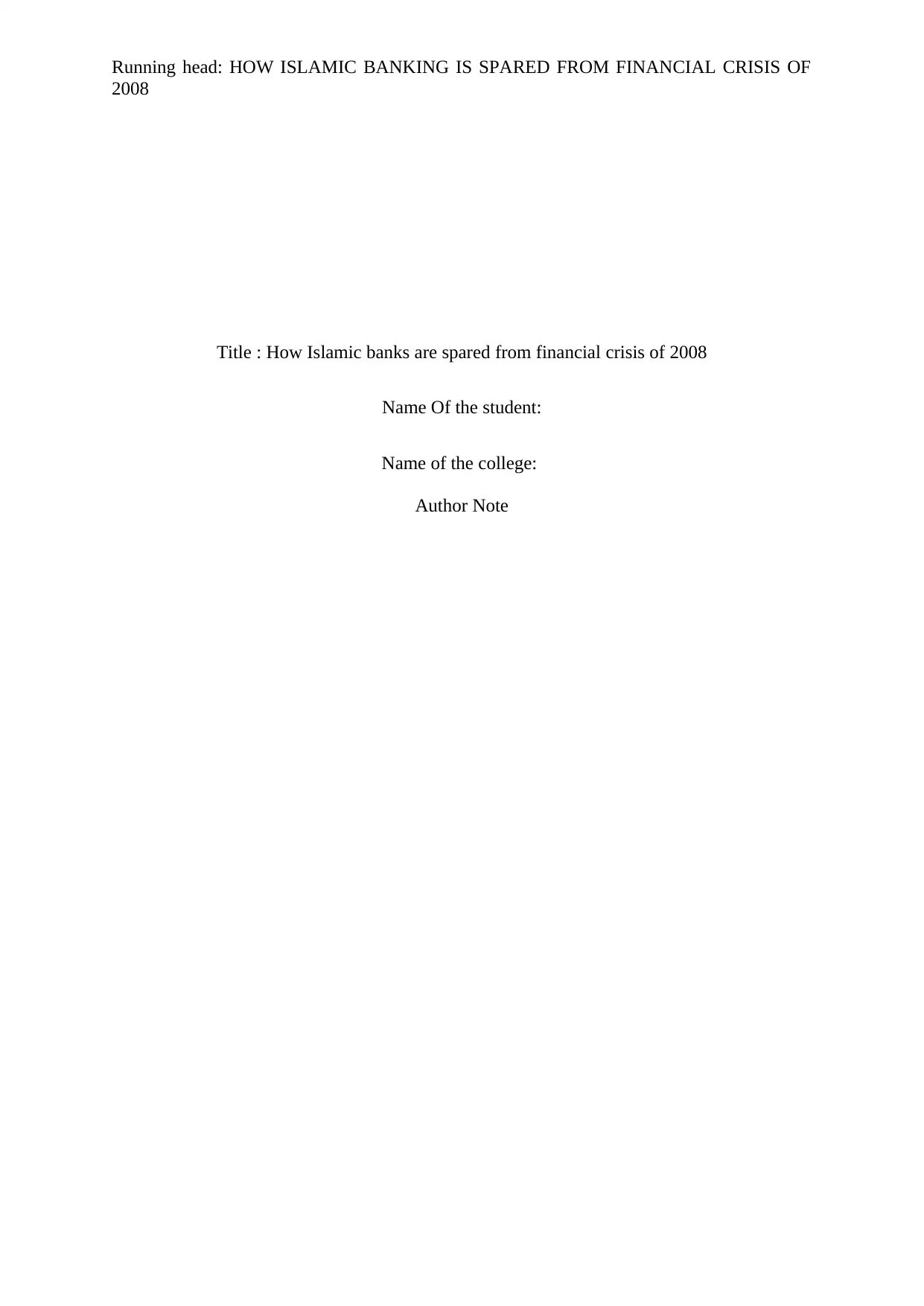
Running head: HOW ISLAMIC BANKING IS SPARED FROM FINANCIAL CRISIS OF
2008
Title : How Islamic banks are spared from financial crisis of 2008
Name Of the student:
Name of the college:
Author Note
2008
Title : How Islamic banks are spared from financial crisis of 2008
Name Of the student:
Name of the college:
Author Note
Secure Best Marks with AI Grader
Need help grading? Try our AI Grader for instant feedback on your assignments.
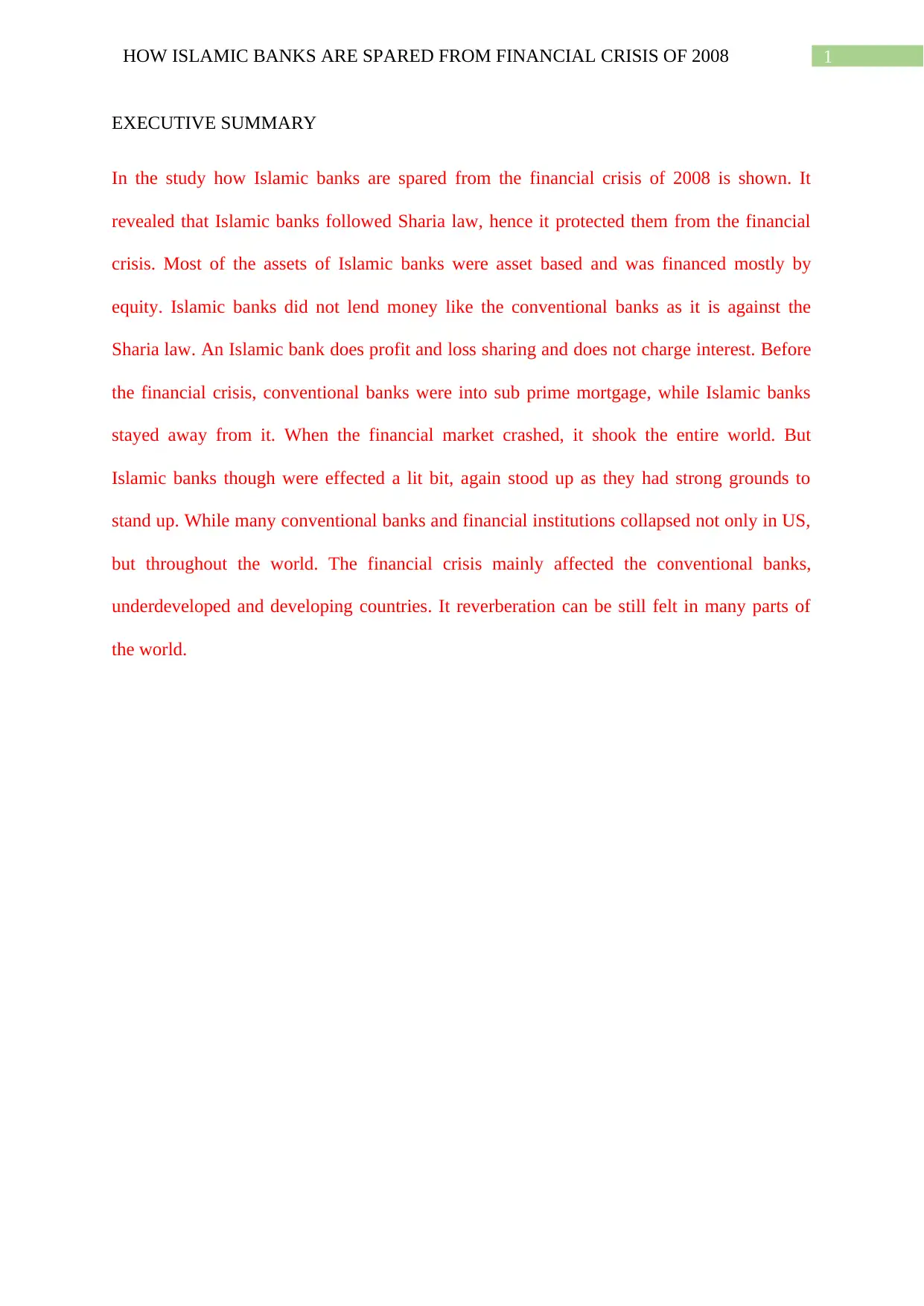
1HOW ISLAMIC BANKS ARE SPARED FROM FINANCIAL CRISIS OF 2008
EXECUTIVE SUMMARY
In the study how Islamic banks are spared from the financial crisis of 2008 is shown. It
revealed that Islamic banks followed Sharia law, hence it protected them from the financial
crisis. Most of the assets of Islamic banks were asset based and was financed mostly by
equity. Islamic banks did not lend money like the conventional banks as it is against the
Sharia law. An Islamic bank does profit and loss sharing and does not charge interest. Before
the financial crisis, conventional banks were into sub prime mortgage, while Islamic banks
stayed away from it. When the financial market crashed, it shook the entire world. But
Islamic banks though were effected a lit bit, again stood up as they had strong grounds to
stand up. While many conventional banks and financial institutions collapsed not only in US,
but throughout the world. The financial crisis mainly affected the conventional banks,
underdeveloped and developing countries. It reverberation can be still felt in many parts of
the world.
EXECUTIVE SUMMARY
In the study how Islamic banks are spared from the financial crisis of 2008 is shown. It
revealed that Islamic banks followed Sharia law, hence it protected them from the financial
crisis. Most of the assets of Islamic banks were asset based and was financed mostly by
equity. Islamic banks did not lend money like the conventional banks as it is against the
Sharia law. An Islamic bank does profit and loss sharing and does not charge interest. Before
the financial crisis, conventional banks were into sub prime mortgage, while Islamic banks
stayed away from it. When the financial market crashed, it shook the entire world. But
Islamic banks though were effected a lit bit, again stood up as they had strong grounds to
stand up. While many conventional banks and financial institutions collapsed not only in US,
but throughout the world. The financial crisis mainly affected the conventional banks,
underdeveloped and developing countries. It reverberation can be still felt in many parts of
the world.
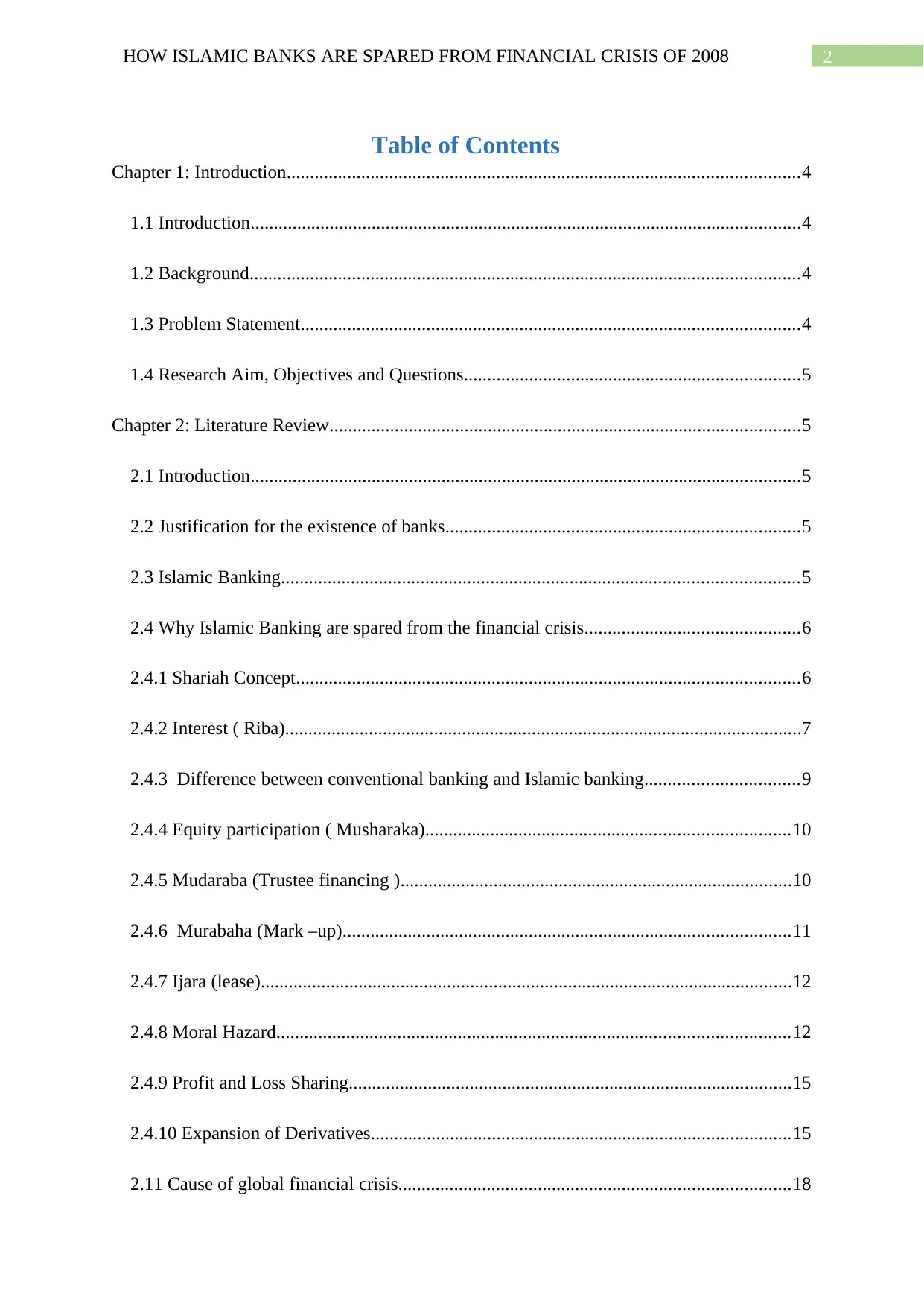
2HOW ISLAMIC BANKS ARE SPARED FROM FINANCIAL CRISIS OF 2008
Table of Contents
Chapter 1: Introduction..............................................................................................................4
1.1 Introduction......................................................................................................................4
1.2 Background......................................................................................................................4
1.3 Problem Statement...........................................................................................................4
1.4 Research Aim, Objectives and Questions........................................................................5
Chapter 2: Literature Review.....................................................................................................5
2.1 Introduction......................................................................................................................5
2.2 Justification for the existence of banks............................................................................5
2.3 Islamic Banking...............................................................................................................5
2.4 Why Islamic Banking are spared from the financial crisis..............................................6
2.4.1 Shariah Concept............................................................................................................6
2.4.2 Interest ( Riba)...............................................................................................................7
2.4.3 Difference between conventional banking and Islamic banking.................................9
2.4.4 Equity participation ( Musharaka)..............................................................................10
2.4.5 Mudaraba (Trustee financing )....................................................................................10
2.4.6 Murabaha (Mark –up)................................................................................................11
2.4.7 Ijara (lease)..................................................................................................................12
2.4.8 Moral Hazard..............................................................................................................12
2.4.9 Profit and Loss Sharing...............................................................................................15
2.4.10 Expansion of Derivatives..........................................................................................15
2.11 Cause of global financial crisis....................................................................................18
Table of Contents
Chapter 1: Introduction..............................................................................................................4
1.1 Introduction......................................................................................................................4
1.2 Background......................................................................................................................4
1.3 Problem Statement...........................................................................................................4
1.4 Research Aim, Objectives and Questions........................................................................5
Chapter 2: Literature Review.....................................................................................................5
2.1 Introduction......................................................................................................................5
2.2 Justification for the existence of banks............................................................................5
2.3 Islamic Banking...............................................................................................................5
2.4 Why Islamic Banking are spared from the financial crisis..............................................6
2.4.1 Shariah Concept............................................................................................................6
2.4.2 Interest ( Riba)...............................................................................................................7
2.4.3 Difference between conventional banking and Islamic banking.................................9
2.4.4 Equity participation ( Musharaka)..............................................................................10
2.4.5 Mudaraba (Trustee financing )....................................................................................10
2.4.6 Murabaha (Mark –up)................................................................................................11
2.4.7 Ijara (lease)..................................................................................................................12
2.4.8 Moral Hazard..............................................................................................................12
2.4.9 Profit and Loss Sharing...............................................................................................15
2.4.10 Expansion of Derivatives..........................................................................................15
2.11 Cause of global financial crisis....................................................................................18
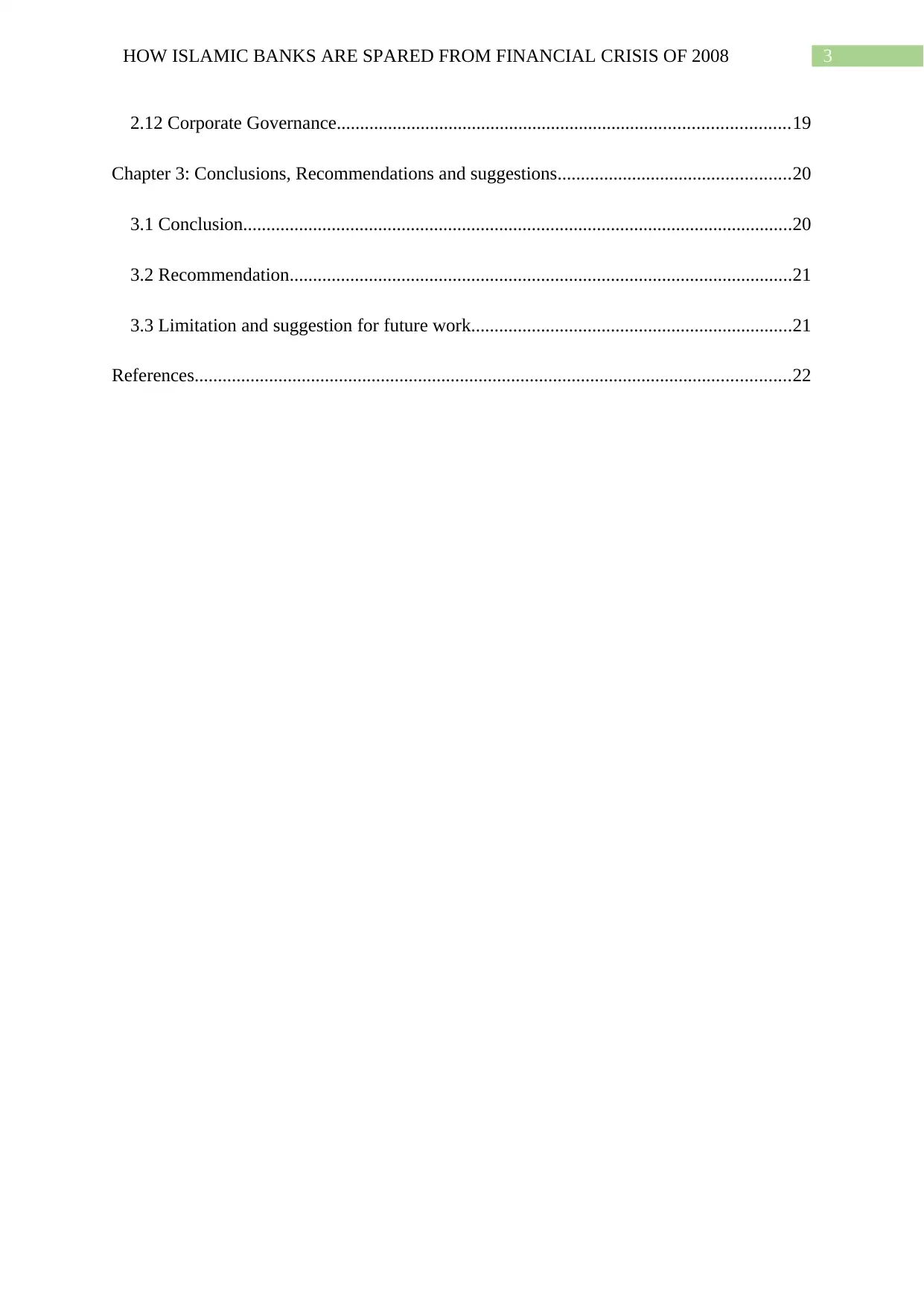
3HOW ISLAMIC BANKS ARE SPARED FROM FINANCIAL CRISIS OF 2008
2.12 Corporate Governance.................................................................................................19
Chapter 3: Conclusions, Recommendations and suggestions..................................................20
3.1 Conclusion......................................................................................................................20
3.2 Recommendation............................................................................................................21
3.3 Limitation and suggestion for future work.....................................................................21
References................................................................................................................................22
2.12 Corporate Governance.................................................................................................19
Chapter 3: Conclusions, Recommendations and suggestions..................................................20
3.1 Conclusion......................................................................................................................20
3.2 Recommendation............................................................................................................21
3.3 Limitation and suggestion for future work.....................................................................21
References................................................................................................................................22
Secure Best Marks with AI Grader
Need help grading? Try our AI Grader for instant feedback on your assignments.
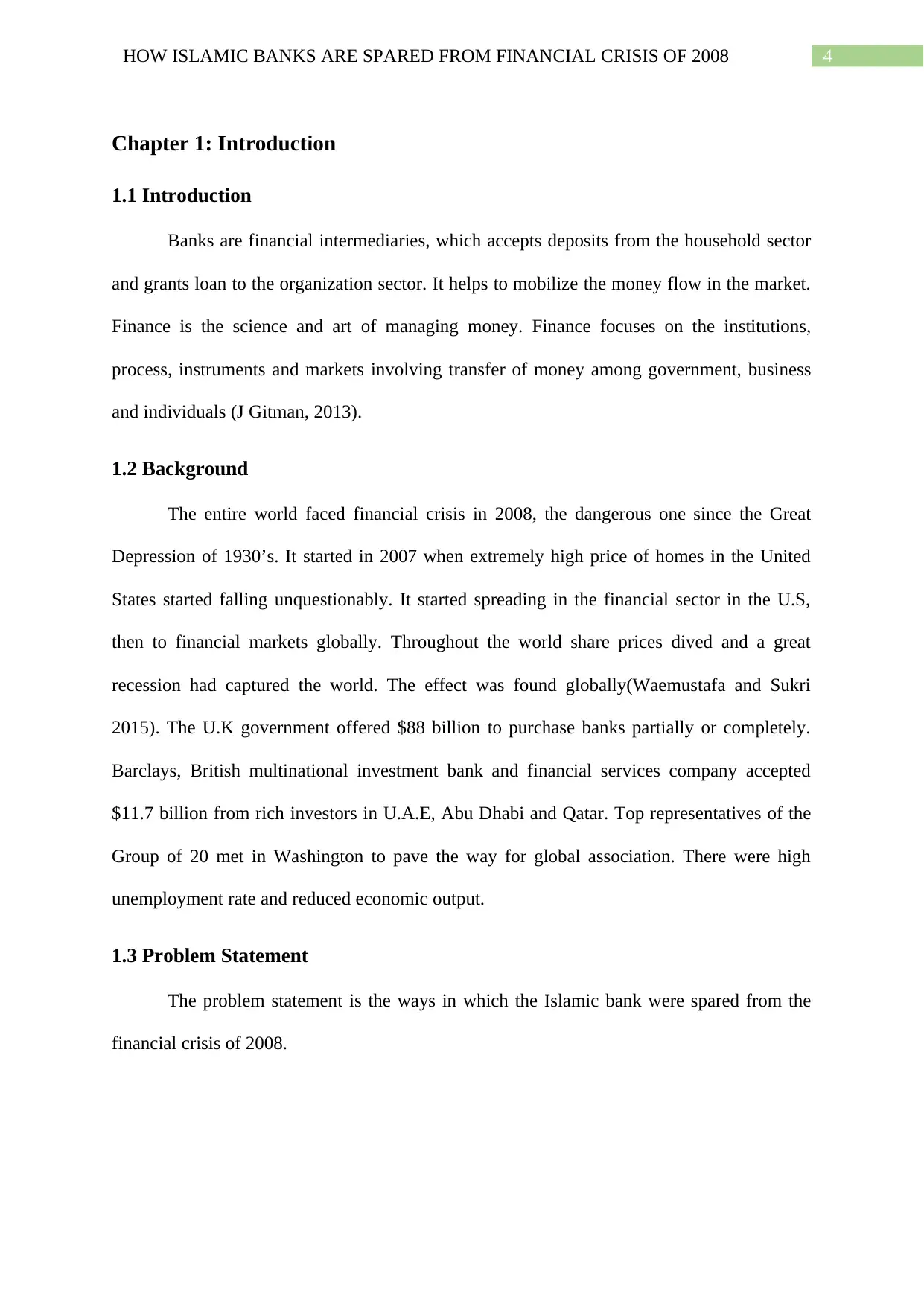
4HOW ISLAMIC BANKS ARE SPARED FROM FINANCIAL CRISIS OF 2008
Chapter 1: Introduction
1.1 Introduction
Banks are financial intermediaries, which accepts deposits from the household sector
and grants loan to the organization sector. It helps to mobilize the money flow in the market.
Finance is the science and art of managing money. Finance focuses on the institutions,
process, instruments and markets involving transfer of money among government, business
and individuals (J Gitman, 2013).
1.2 Background
The entire world faced financial crisis in 2008, the dangerous one since the Great
Depression of 1930’s. It started in 2007 when extremely high price of homes in the United
States started falling unquestionably. It started spreading in the financial sector in the U.S,
then to financial markets globally. Throughout the world share prices dived and a great
recession had captured the world. The effect was found globally(Waemustafa and Sukri
2015). The U.K government offered $88 billion to purchase banks partially or completely.
Barclays, British multinational investment bank and financial services company accepted
$11.7 billion from rich investors in U.A.E, Abu Dhabi and Qatar. Top representatives of the
Group of 20 met in Washington to pave the way for global association. There were high
unemployment rate and reduced economic output.
1.3 Problem Statement
The problem statement is the ways in which the Islamic bank were spared from the
financial crisis of 2008.
Chapter 1: Introduction
1.1 Introduction
Banks are financial intermediaries, which accepts deposits from the household sector
and grants loan to the organization sector. It helps to mobilize the money flow in the market.
Finance is the science and art of managing money. Finance focuses on the institutions,
process, instruments and markets involving transfer of money among government, business
and individuals (J Gitman, 2013).
1.2 Background
The entire world faced financial crisis in 2008, the dangerous one since the Great
Depression of 1930’s. It started in 2007 when extremely high price of homes in the United
States started falling unquestionably. It started spreading in the financial sector in the U.S,
then to financial markets globally. Throughout the world share prices dived and a great
recession had captured the world. The effect was found globally(Waemustafa and Sukri
2015). The U.K government offered $88 billion to purchase banks partially or completely.
Barclays, British multinational investment bank and financial services company accepted
$11.7 billion from rich investors in U.A.E, Abu Dhabi and Qatar. Top representatives of the
Group of 20 met in Washington to pave the way for global association. There were high
unemployment rate and reduced economic output.
1.3 Problem Statement
The problem statement is the ways in which the Islamic bank were spared from the
financial crisis of 2008.
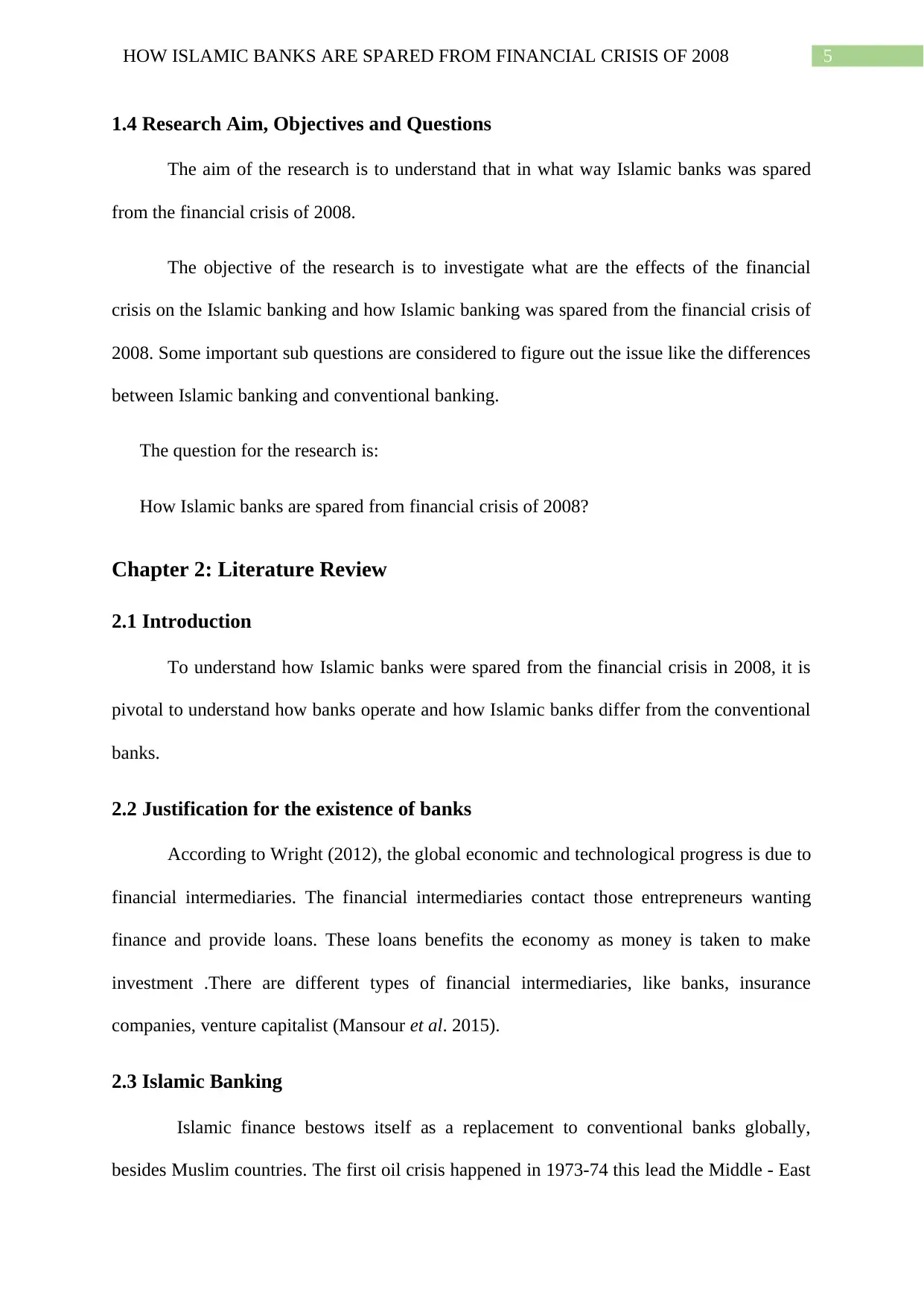
5HOW ISLAMIC BANKS ARE SPARED FROM FINANCIAL CRISIS OF 2008
1.4 Research Aim, Objectives and Questions
The aim of the research is to understand that in what way Islamic banks was spared
from the financial crisis of 2008.
The objective of the research is to investigate what are the effects of the financial
crisis on the Islamic banking and how Islamic banking was spared from the financial crisis of
2008. Some important sub questions are considered to figure out the issue like the differences
between Islamic banking and conventional banking.
The question for the research is:
How Islamic banks are spared from financial crisis of 2008?
Chapter 2: Literature Review
2.1 Introduction
To understand how Islamic banks were spared from the financial crisis in 2008, it is
pivotal to understand how banks operate and how Islamic banks differ from the conventional
banks.
2.2 Justification for the existence of banks
According to Wright (2012), the global economic and technological progress is due to
financial intermediaries. The financial intermediaries contact those entrepreneurs wanting
finance and provide loans. These loans benefits the economy as money is taken to make
investment .There are different types of financial intermediaries, like banks, insurance
companies, venture capitalist (Mansour et al. 2015).
2.3 Islamic Banking
Islamic finance bestows itself as a replacement to conventional banks globally,
besides Muslim countries. The first oil crisis happened in 1973-74 this lead the Middle - East
1.4 Research Aim, Objectives and Questions
The aim of the research is to understand that in what way Islamic banks was spared
from the financial crisis of 2008.
The objective of the research is to investigate what are the effects of the financial
crisis on the Islamic banking and how Islamic banking was spared from the financial crisis of
2008. Some important sub questions are considered to figure out the issue like the differences
between Islamic banking and conventional banking.
The question for the research is:
How Islamic banks are spared from financial crisis of 2008?
Chapter 2: Literature Review
2.1 Introduction
To understand how Islamic banks were spared from the financial crisis in 2008, it is
pivotal to understand how banks operate and how Islamic banks differ from the conventional
banks.
2.2 Justification for the existence of banks
According to Wright (2012), the global economic and technological progress is due to
financial intermediaries. The financial intermediaries contact those entrepreneurs wanting
finance and provide loans. These loans benefits the economy as money is taken to make
investment .There are different types of financial intermediaries, like banks, insurance
companies, venture capitalist (Mansour et al. 2015).
2.3 Islamic Banking
Islamic finance bestows itself as a replacement to conventional banks globally,
besides Muslim countries. The first oil crisis happened in 1973-74 this lead the Middle - East
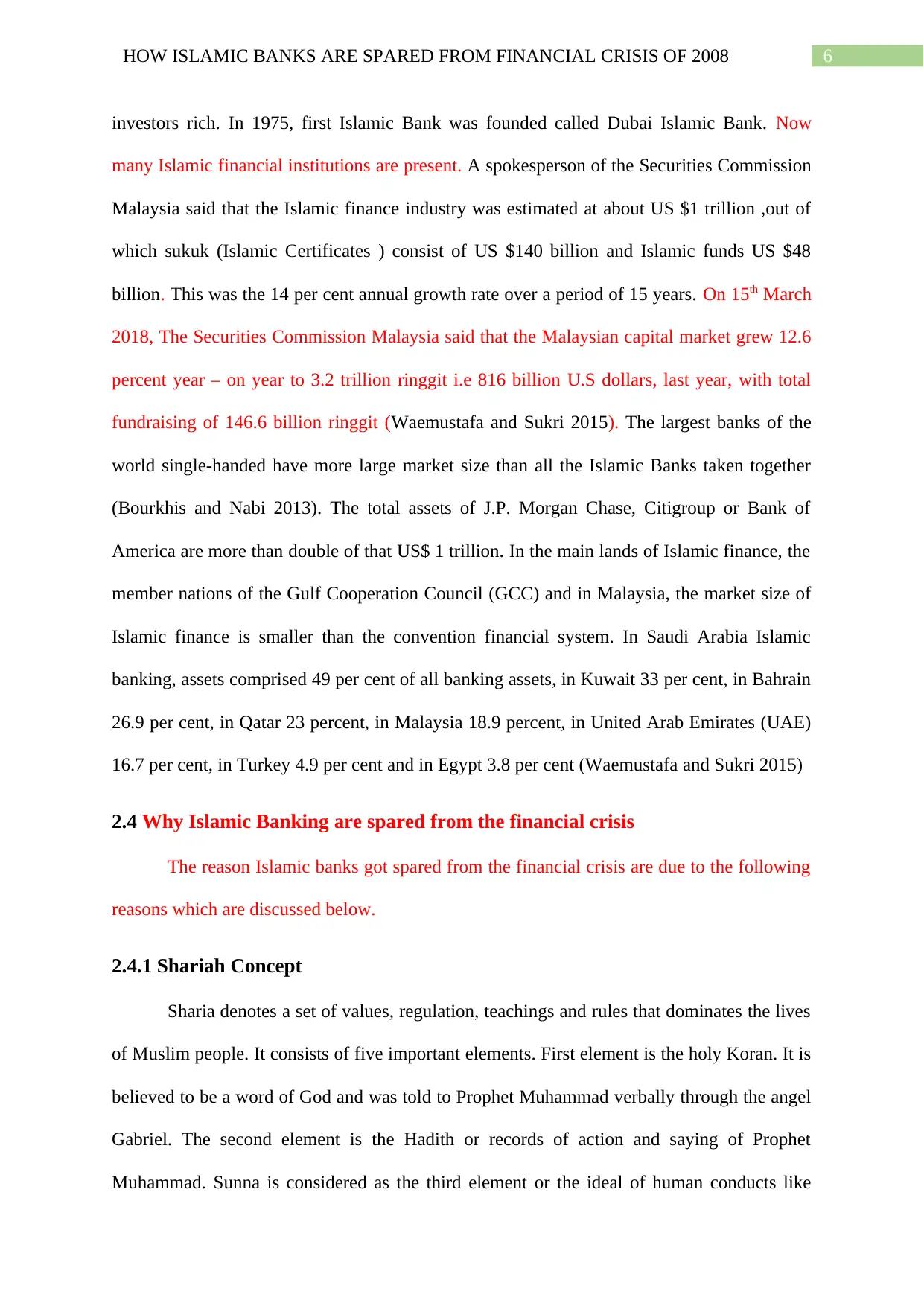
6HOW ISLAMIC BANKS ARE SPARED FROM FINANCIAL CRISIS OF 2008
investors rich. In 1975, first Islamic Bank was founded called Dubai Islamic Bank. Now
many Islamic financial institutions are present. A spokesperson of the Securities Commission
Malaysia said that the Islamic finance industry was estimated at about US $1 trillion ,out of
which sukuk (Islamic Certificates ) consist of US $140 billion and Islamic funds US $48
billion. This was the 14 per cent annual growth rate over a period of 15 years. On 15th March
2018, The Securities Commission Malaysia said that the Malaysian capital market grew 12.6
percent year – on year to 3.2 trillion ringgit i.e 816 billion U.S dollars, last year, with total
fundraising of 146.6 billion ringgit (Waemustafa and Sukri 2015). The largest banks of the
world single-handed have more large market size than all the Islamic Banks taken together
(Bourkhis and Nabi 2013). The total assets of J.P. Morgan Chase, Citigroup or Bank of
America are more than double of that US$ 1 trillion. In the main lands of Islamic finance, the
member nations of the Gulf Cooperation Council (GCC) and in Malaysia, the market size of
Islamic finance is smaller than the convention financial system. In Saudi Arabia Islamic
banking, assets comprised 49 per cent of all banking assets, in Kuwait 33 per cent, in Bahrain
26.9 per cent, in Qatar 23 percent, in Malaysia 18.9 percent, in United Arab Emirates (UAE)
16.7 per cent, in Turkey 4.9 per cent and in Egypt 3.8 per cent (Waemustafa and Sukri 2015)
2.4 Why Islamic Banking are spared from the financial crisis
The reason Islamic banks got spared from the financial crisis are due to the following
reasons which are discussed below.
2.4.1 Shariah Concept
Sharia denotes a set of values, regulation, teachings and rules that dominates the lives
of Muslim people. It consists of five important elements. First element is the holy Koran. It is
believed to be a word of God and was told to Prophet Muhammad verbally through the angel
Gabriel. The second element is the Hadith or records of action and saying of Prophet
Muhammad. Sunna is considered as the third element or the ideal of human conducts like
investors rich. In 1975, first Islamic Bank was founded called Dubai Islamic Bank. Now
many Islamic financial institutions are present. A spokesperson of the Securities Commission
Malaysia said that the Islamic finance industry was estimated at about US $1 trillion ,out of
which sukuk (Islamic Certificates ) consist of US $140 billion and Islamic funds US $48
billion. This was the 14 per cent annual growth rate over a period of 15 years. On 15th March
2018, The Securities Commission Malaysia said that the Malaysian capital market grew 12.6
percent year – on year to 3.2 trillion ringgit i.e 816 billion U.S dollars, last year, with total
fundraising of 146.6 billion ringgit (Waemustafa and Sukri 2015). The largest banks of the
world single-handed have more large market size than all the Islamic Banks taken together
(Bourkhis and Nabi 2013). The total assets of J.P. Morgan Chase, Citigroup or Bank of
America are more than double of that US$ 1 trillion. In the main lands of Islamic finance, the
member nations of the Gulf Cooperation Council (GCC) and in Malaysia, the market size of
Islamic finance is smaller than the convention financial system. In Saudi Arabia Islamic
banking, assets comprised 49 per cent of all banking assets, in Kuwait 33 per cent, in Bahrain
26.9 per cent, in Qatar 23 percent, in Malaysia 18.9 percent, in United Arab Emirates (UAE)
16.7 per cent, in Turkey 4.9 per cent and in Egypt 3.8 per cent (Waemustafa and Sukri 2015)
2.4 Why Islamic Banking are spared from the financial crisis
The reason Islamic banks got spared from the financial crisis are due to the following
reasons which are discussed below.
2.4.1 Shariah Concept
Sharia denotes a set of values, regulation, teachings and rules that dominates the lives
of Muslim people. It consists of five important elements. First element is the holy Koran. It is
believed to be a word of God and was told to Prophet Muhammad verbally through the angel
Gabriel. The second element is the Hadith or records of action and saying of Prophet
Muhammad. Sunna is considered as the third element or the ideal of human conducts like
Paraphrase This Document
Need a fresh take? Get an instant paraphrase of this document with our AI Paraphraser
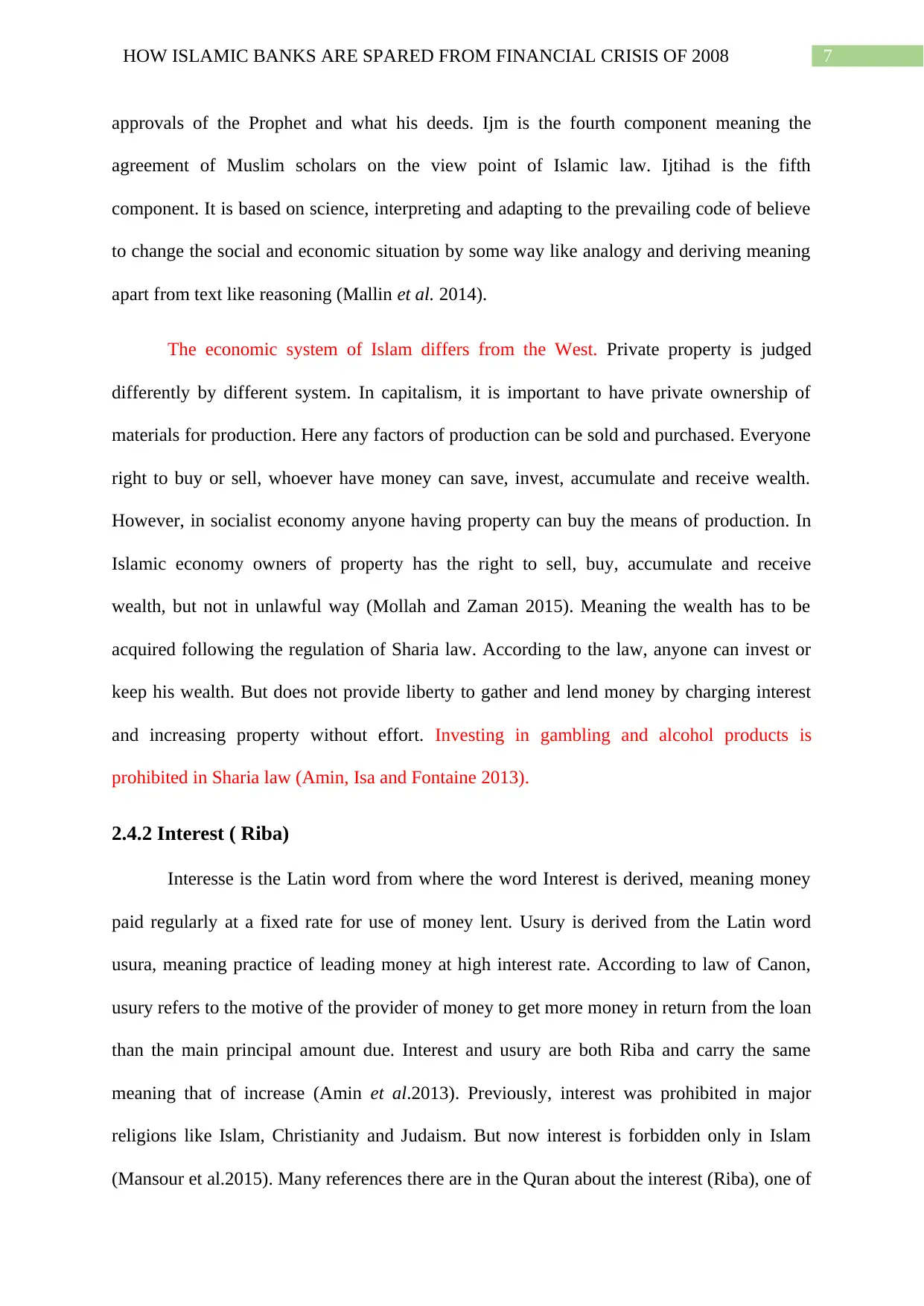
7HOW ISLAMIC BANKS ARE SPARED FROM FINANCIAL CRISIS OF 2008
approvals of the Prophet and what his deeds. Ijm is the fourth component meaning the
agreement of Muslim scholars on the view point of Islamic law. Ijtihad is the fifth
component. It is based on science, interpreting and adapting to the prevailing code of believe
to change the social and economic situation by some way like analogy and deriving meaning
apart from text like reasoning (Mallin et al. 2014).
The economic system of Islam differs from the West. Private property is judged
differently by different system. In capitalism, it is important to have private ownership of
materials for production. Here any factors of production can be sold and purchased. Everyone
right to buy or sell, whoever have money can save, invest, accumulate and receive wealth.
However, in socialist economy anyone having property can buy the means of production. In
Islamic economy owners of property has the right to sell, buy, accumulate and receive
wealth, but not in unlawful way (Mollah and Zaman 2015). Meaning the wealth has to be
acquired following the regulation of Sharia law. According to the law, anyone can invest or
keep his wealth. But does not provide liberty to gather and lend money by charging interest
and increasing property without effort. Investing in gambling and alcohol products is
prohibited in Sharia law (Amin, Isa and Fontaine 2013).
2.4.2 Interest ( Riba)
Interesse is the Latin word from where the word Interest is derived, meaning money
paid regularly at a fixed rate for use of money lent. Usury is derived from the Latin word
usura, meaning practice of leading money at high interest rate. According to law of Canon,
usury refers to the motive of the provider of money to get more money in return from the loan
than the main principal amount due. Interest and usury are both Riba and carry the same
meaning that of increase (Amin et al.2013). Previously, interest was prohibited in major
religions like Islam, Christianity and Judaism. But now interest is forbidden only in Islam
(Mansour et al.2015). Many references there are in the Quran about the interest (Riba), one of
approvals of the Prophet and what his deeds. Ijm is the fourth component meaning the
agreement of Muslim scholars on the view point of Islamic law. Ijtihad is the fifth
component. It is based on science, interpreting and adapting to the prevailing code of believe
to change the social and economic situation by some way like analogy and deriving meaning
apart from text like reasoning (Mallin et al. 2014).
The economic system of Islam differs from the West. Private property is judged
differently by different system. In capitalism, it is important to have private ownership of
materials for production. Here any factors of production can be sold and purchased. Everyone
right to buy or sell, whoever have money can save, invest, accumulate and receive wealth.
However, in socialist economy anyone having property can buy the means of production. In
Islamic economy owners of property has the right to sell, buy, accumulate and receive
wealth, but not in unlawful way (Mollah and Zaman 2015). Meaning the wealth has to be
acquired following the regulation of Sharia law. According to the law, anyone can invest or
keep his wealth. But does not provide liberty to gather and lend money by charging interest
and increasing property without effort. Investing in gambling and alcohol products is
prohibited in Sharia law (Amin, Isa and Fontaine 2013).
2.4.2 Interest ( Riba)
Interesse is the Latin word from where the word Interest is derived, meaning money
paid regularly at a fixed rate for use of money lent. Usury is derived from the Latin word
usura, meaning practice of leading money at high interest rate. According to law of Canon,
usury refers to the motive of the provider of money to get more money in return from the loan
than the main principal amount due. Interest and usury are both Riba and carry the same
meaning that of increase (Amin et al.2013). Previously, interest was prohibited in major
religions like Islam, Christianity and Judaism. But now interest is forbidden only in Islam
(Mansour et al.2015). Many references there are in the Quran about the interest (Riba), one of
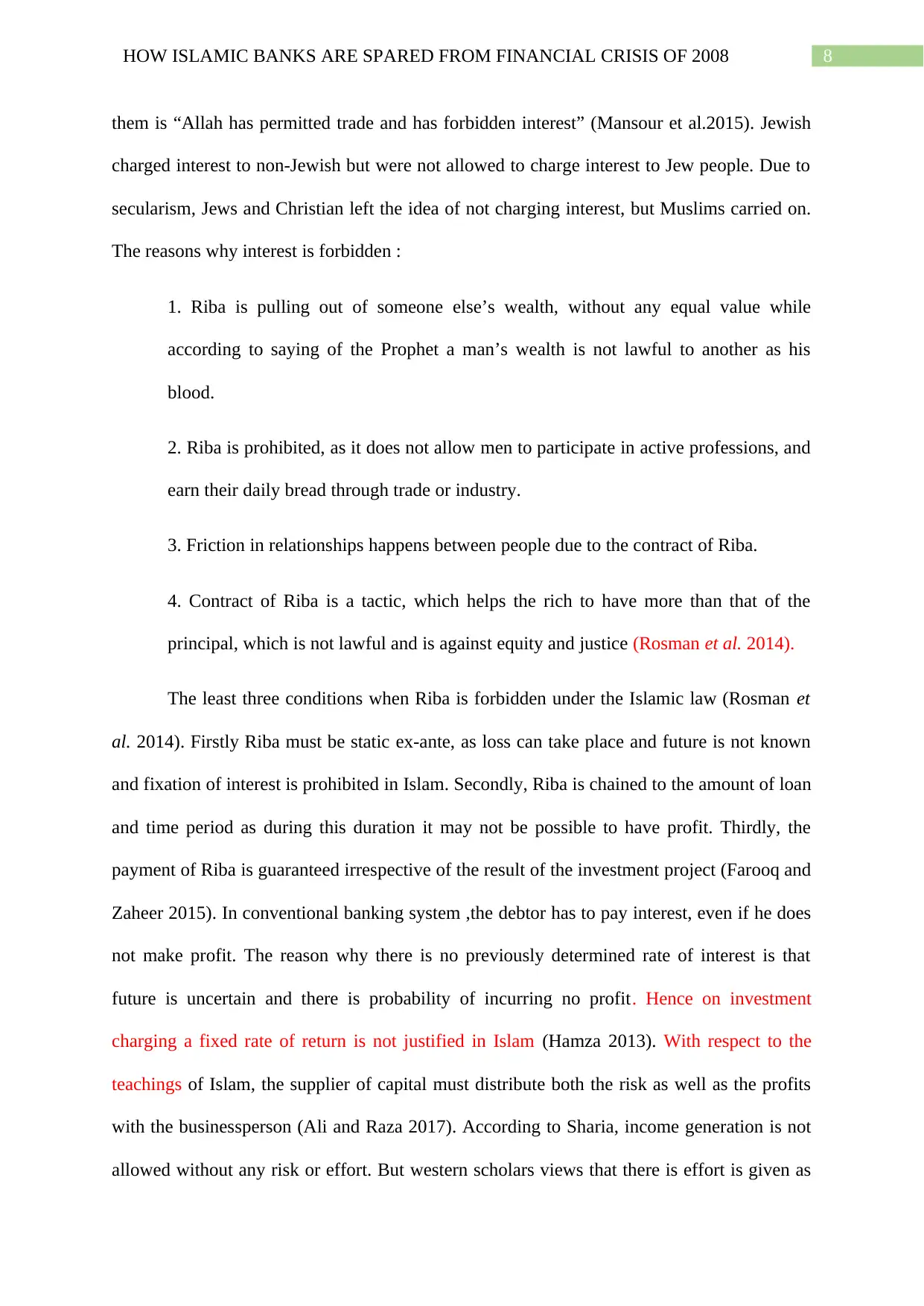
8HOW ISLAMIC BANKS ARE SPARED FROM FINANCIAL CRISIS OF 2008
them is “Allah has permitted trade and has forbidden interest” (Mansour et al.2015). Jewish
charged interest to non-Jewish but were not allowed to charge interest to Jew people. Due to
secularism, Jews and Christian left the idea of not charging interest, but Muslims carried on.
The reasons why interest is forbidden :
1. Riba is pulling out of someone else’s wealth, without any equal value while
according to saying of the Prophet a man’s wealth is not lawful to another as his
blood.
2. Riba is prohibited, as it does not allow men to participate in active professions, and
earn their daily bread through trade or industry.
3. Friction in relationships happens between people due to the contract of Riba.
4. Contract of Riba is a tactic, which helps the rich to have more than that of the
principal, which is not lawful and is against equity and justice (Rosman et al. 2014).
The least three conditions when Riba is forbidden under the Islamic law (Rosman et
al. 2014). Firstly Riba must be static ex-ante, as loss can take place and future is not known
and fixation of interest is prohibited in Islam. Secondly, Riba is chained to the amount of loan
and time period as during this duration it may not be possible to have profit. Thirdly, the
payment of Riba is guaranteed irrespective of the result of the investment project (Farooq and
Zaheer 2015). In conventional banking system ,the debtor has to pay interest, even if he does
not make profit. The reason why there is no previously determined rate of interest is that
future is uncertain and there is probability of incurring no profit. Hence on investment
charging a fixed rate of return is not justified in Islam (Hamza 2013). With respect to the
teachings of Islam, the supplier of capital must distribute both the risk as well as the profits
with the businessperson (Ali and Raza 2017). According to Sharia, income generation is not
allowed without any risk or effort. But western scholars views that there is effort is given as
them is “Allah has permitted trade and has forbidden interest” (Mansour et al.2015). Jewish
charged interest to non-Jewish but were not allowed to charge interest to Jew people. Due to
secularism, Jews and Christian left the idea of not charging interest, but Muslims carried on.
The reasons why interest is forbidden :
1. Riba is pulling out of someone else’s wealth, without any equal value while
according to saying of the Prophet a man’s wealth is not lawful to another as his
blood.
2. Riba is prohibited, as it does not allow men to participate in active professions, and
earn their daily bread through trade or industry.
3. Friction in relationships happens between people due to the contract of Riba.
4. Contract of Riba is a tactic, which helps the rich to have more than that of the
principal, which is not lawful and is against equity and justice (Rosman et al. 2014).
The least three conditions when Riba is forbidden under the Islamic law (Rosman et
al. 2014). Firstly Riba must be static ex-ante, as loss can take place and future is not known
and fixation of interest is prohibited in Islam. Secondly, Riba is chained to the amount of loan
and time period as during this duration it may not be possible to have profit. Thirdly, the
payment of Riba is guaranteed irrespective of the result of the investment project (Farooq and
Zaheer 2015). In conventional banking system ,the debtor has to pay interest, even if he does
not make profit. The reason why there is no previously determined rate of interest is that
future is uncertain and there is probability of incurring no profit. Hence on investment
charging a fixed rate of return is not justified in Islam (Hamza 2013). With respect to the
teachings of Islam, the supplier of capital must distribute both the risk as well as the profits
with the businessperson (Ali and Raza 2017). According to Sharia, income generation is not
allowed without any risk or effort. But western scholars views that there is effort is given as
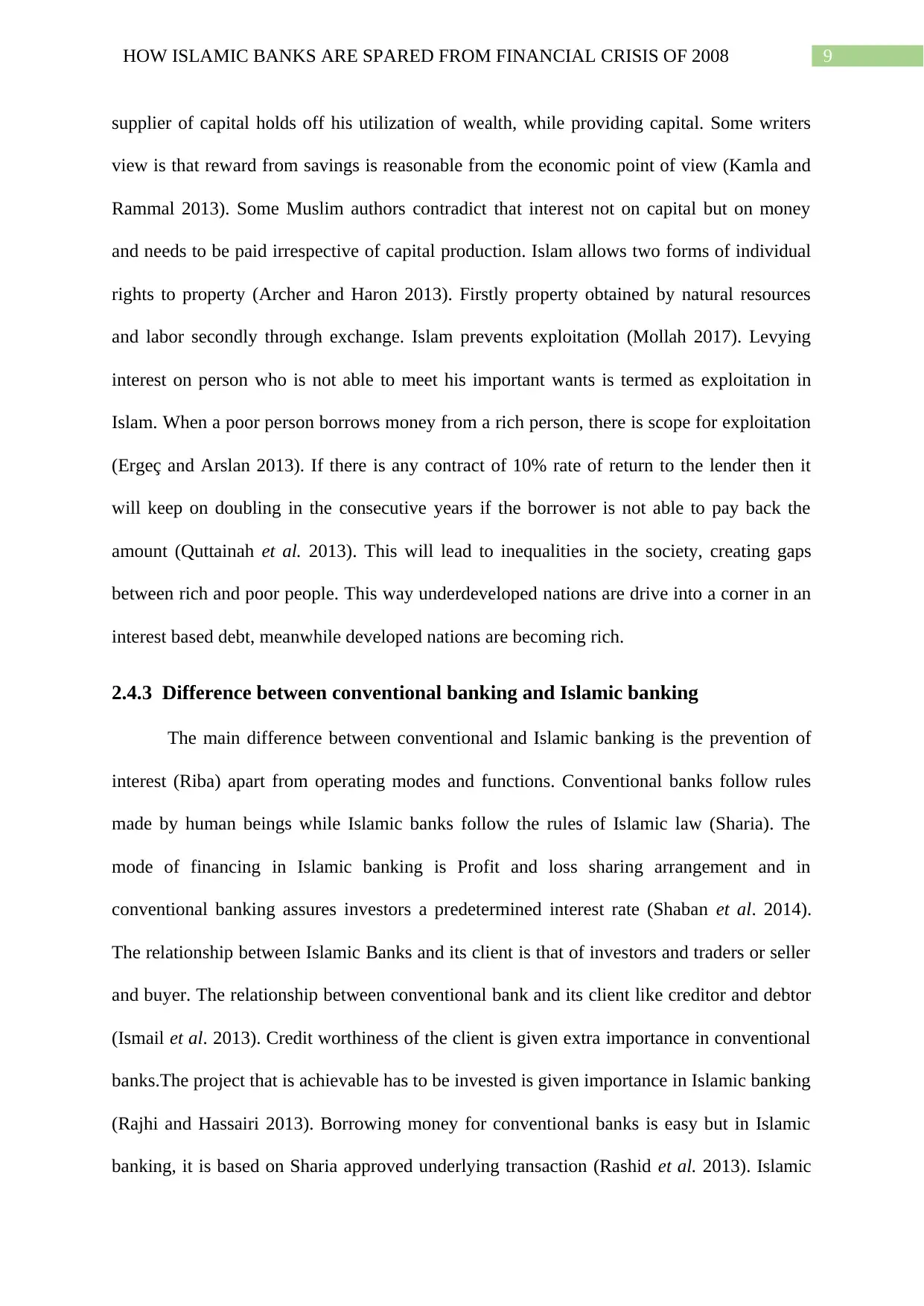
9HOW ISLAMIC BANKS ARE SPARED FROM FINANCIAL CRISIS OF 2008
supplier of capital holds off his utilization of wealth, while providing capital. Some writers
view is that reward from savings is reasonable from the economic point of view (Kamla and
Rammal 2013). Some Muslim authors contradict that interest not on capital but on money
and needs to be paid irrespective of capital production. Islam allows two forms of individual
rights to property (Archer and Haron 2013). Firstly property obtained by natural resources
and labor secondly through exchange. Islam prevents exploitation (Mollah 2017). Levying
interest on person who is not able to meet his important wants is termed as exploitation in
Islam. When a poor person borrows money from a rich person, there is scope for exploitation
(Ergeç and Arslan 2013). If there is any contract of 10% rate of return to the lender then it
will keep on doubling in the consecutive years if the borrower is not able to pay back the
amount (Quttainah et al. 2013). This will lead to inequalities in the society, creating gaps
between rich and poor people. This way underdeveloped nations are drive into a corner in an
interest based debt, meanwhile developed nations are becoming rich.
2.4.3 Difference between conventional banking and Islamic banking
The main difference between conventional and Islamic banking is the prevention of
interest (Riba) apart from operating modes and functions. Conventional banks follow rules
made by human beings while Islamic banks follow the rules of Islamic law (Sharia). The
mode of financing in Islamic banking is Profit and loss sharing arrangement and in
conventional banking assures investors a predetermined interest rate (Shaban et al. 2014).
The relationship between Islamic Banks and its client is that of investors and traders or seller
and buyer. The relationship between conventional bank and its client like creditor and debtor
(Ismail et al. 2013). Credit worthiness of the client is given extra importance in conventional
banks.The project that is achievable has to be invested is given importance in Islamic banking
(Rajhi and Hassairi 2013). Borrowing money for conventional banks is easy but in Islamic
banking, it is based on Sharia approved underlying transaction (Rashid et al. 2013). Islamic
supplier of capital holds off his utilization of wealth, while providing capital. Some writers
view is that reward from savings is reasonable from the economic point of view (Kamla and
Rammal 2013). Some Muslim authors contradict that interest not on capital but on money
and needs to be paid irrespective of capital production. Islam allows two forms of individual
rights to property (Archer and Haron 2013). Firstly property obtained by natural resources
and labor secondly through exchange. Islam prevents exploitation (Mollah 2017). Levying
interest on person who is not able to meet his important wants is termed as exploitation in
Islam. When a poor person borrows money from a rich person, there is scope for exploitation
(Ergeç and Arslan 2013). If there is any contract of 10% rate of return to the lender then it
will keep on doubling in the consecutive years if the borrower is not able to pay back the
amount (Quttainah et al. 2013). This will lead to inequalities in the society, creating gaps
between rich and poor people. This way underdeveloped nations are drive into a corner in an
interest based debt, meanwhile developed nations are becoming rich.
2.4.3 Difference between conventional banking and Islamic banking
The main difference between conventional and Islamic banking is the prevention of
interest (Riba) apart from operating modes and functions. Conventional banks follow rules
made by human beings while Islamic banks follow the rules of Islamic law (Sharia). The
mode of financing in Islamic banking is Profit and loss sharing arrangement and in
conventional banking assures investors a predetermined interest rate (Shaban et al. 2014).
The relationship between Islamic Banks and its client is that of investors and traders or seller
and buyer. The relationship between conventional bank and its client like creditor and debtor
(Ismail et al. 2013). Credit worthiness of the client is given extra importance in conventional
banks.The project that is achievable has to be invested is given importance in Islamic banking
(Rajhi and Hassairi 2013). Borrowing money for conventional banks is easy but in Islamic
banking, it is based on Sharia approved underlying transaction (Rashid et al. 2013). Islamic
Secure Best Marks with AI Grader
Need help grading? Try our AI Grader for instant feedback on your assignments.
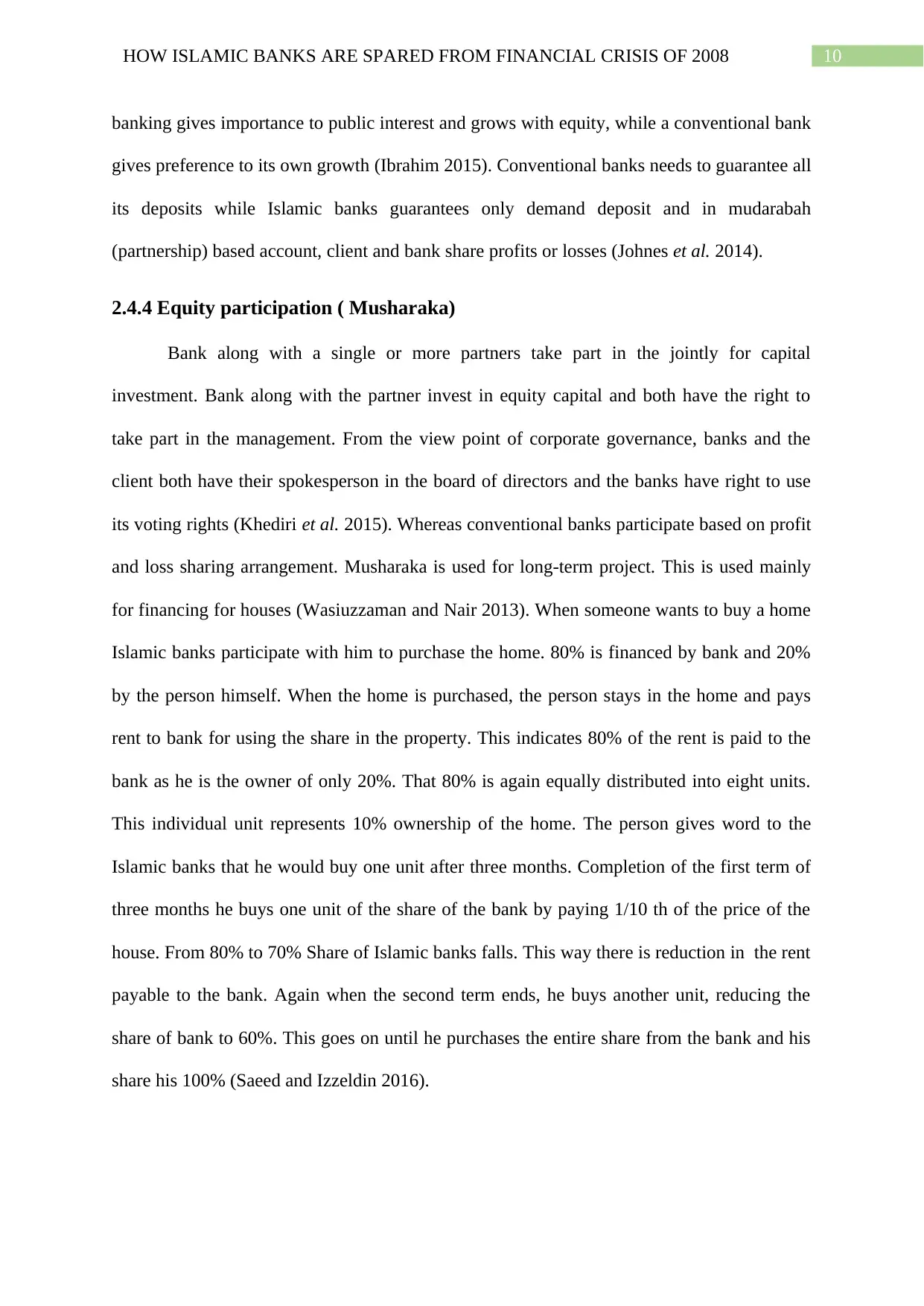
10HOW ISLAMIC BANKS ARE SPARED FROM FINANCIAL CRISIS OF 2008
banking gives importance to public interest and grows with equity, while a conventional bank
gives preference to its own growth (Ibrahim 2015). Conventional banks needs to guarantee all
its deposits while Islamic banks guarantees only demand deposit and in mudarabah
(partnership) based account, client and bank share profits or losses (Johnes et al. 2014).
2.4.4 Equity participation ( Musharaka)
Bank along with a single or more partners take part in the jointly for capital
investment. Bank along with the partner invest in equity capital and both have the right to
take part in the management. From the view point of corporate governance, banks and the
client both have their spokesperson in the board of directors and the banks have right to use
its voting rights (Khediri et al. 2015). Whereas conventional banks participate based on profit
and loss sharing arrangement. Musharaka is used for long-term project. This is used mainly
for financing for houses (Wasiuzzaman and Nair 2013). When someone wants to buy a home
Islamic banks participate with him to purchase the home. 80% is financed by bank and 20%
by the person himself. When the home is purchased, the person stays in the home and pays
rent to bank for using the share in the property. This indicates 80% of the rent is paid to the
bank as he is the owner of only 20%. That 80% is again equally distributed into eight units.
This individual unit represents 10% ownership of the home. The person gives word to the
Islamic banks that he would buy one unit after three months. Completion of the first term of
three months he buys one unit of the share of the bank by paying 1/10 th of the price of the
house. From 80% to 70% Share of Islamic banks falls. This way there is reduction in the rent
payable to the bank. Again when the second term ends, he buys another unit, reducing the
share of bank to 60%. This goes on until he purchases the entire share from the bank and his
share his 100% (Saeed and Izzeldin 2016).
banking gives importance to public interest and grows with equity, while a conventional bank
gives preference to its own growth (Ibrahim 2015). Conventional banks needs to guarantee all
its deposits while Islamic banks guarantees only demand deposit and in mudarabah
(partnership) based account, client and bank share profits or losses (Johnes et al. 2014).
2.4.4 Equity participation ( Musharaka)
Bank along with a single or more partners take part in the jointly for capital
investment. Bank along with the partner invest in equity capital and both have the right to
take part in the management. From the view point of corporate governance, banks and the
client both have their spokesperson in the board of directors and the banks have right to use
its voting rights (Khediri et al. 2015). Whereas conventional banks participate based on profit
and loss sharing arrangement. Musharaka is used for long-term project. This is used mainly
for financing for houses (Wasiuzzaman and Nair 2013). When someone wants to buy a home
Islamic banks participate with him to purchase the home. 80% is financed by bank and 20%
by the person himself. When the home is purchased, the person stays in the home and pays
rent to bank for using the share in the property. This indicates 80% of the rent is paid to the
bank as he is the owner of only 20%. That 80% is again equally distributed into eight units.
This individual unit represents 10% ownership of the home. The person gives word to the
Islamic banks that he would buy one unit after three months. Completion of the first term of
three months he buys one unit of the share of the bank by paying 1/10 th of the price of the
house. From 80% to 70% Share of Islamic banks falls. This way there is reduction in the rent
payable to the bank. Again when the second term ends, he buys another unit, reducing the
share of bank to 60%. This goes on until he purchases the entire share from the bank and his
share his 100% (Saeed and Izzeldin 2016).
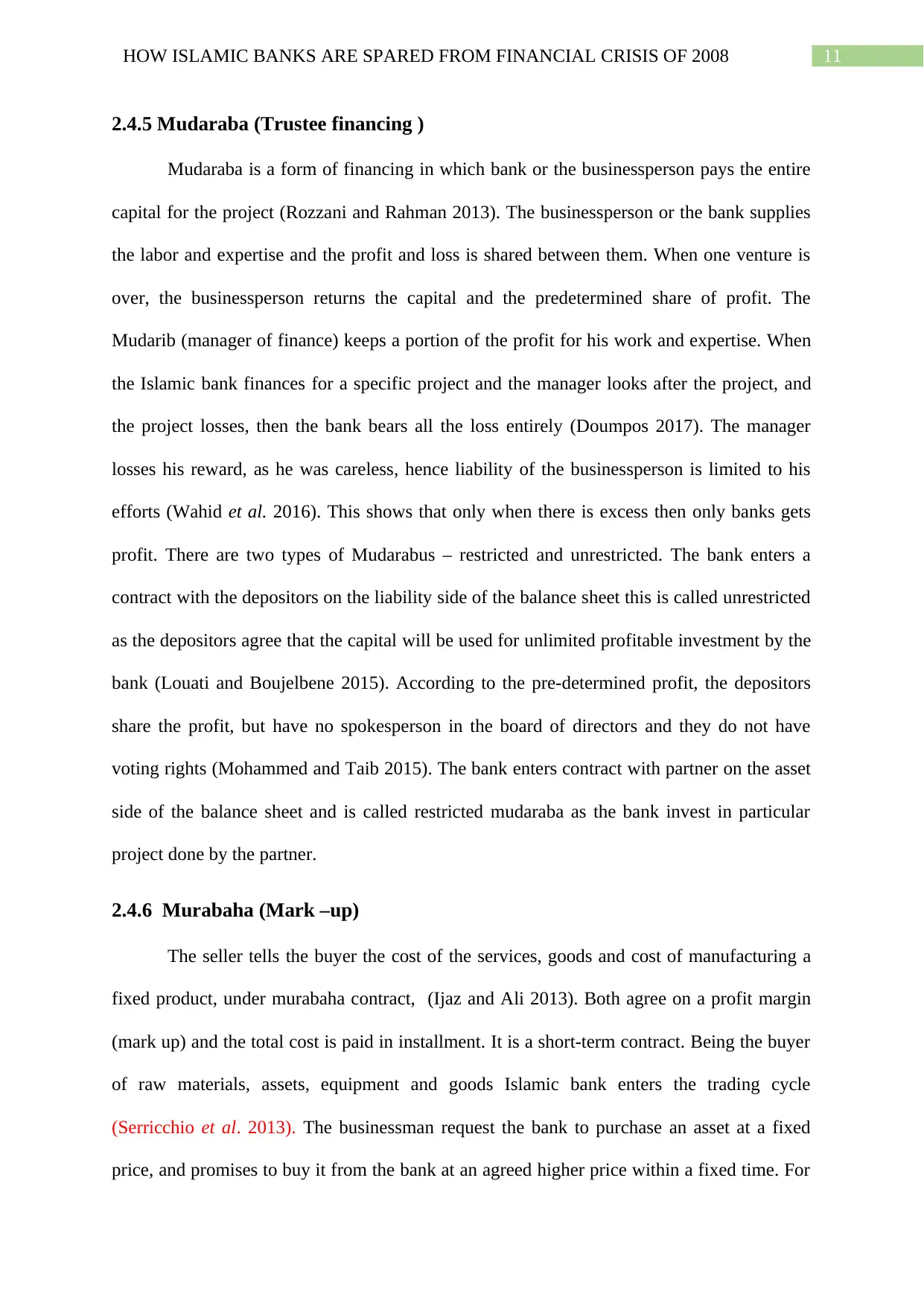
11HOW ISLAMIC BANKS ARE SPARED FROM FINANCIAL CRISIS OF 2008
2.4.5 Mudaraba (Trustee financing )
Mudaraba is a form of financing in which bank or the businessperson pays the entire
capital for the project (Rozzani and Rahman 2013). The businessperson or the bank supplies
the labor and expertise and the profit and loss is shared between them. When one venture is
over, the businessperson returns the capital and the predetermined share of profit. The
Mudarib (manager of finance) keeps a portion of the profit for his work and expertise. When
the Islamic bank finances for a specific project and the manager looks after the project, and
the project losses, then the bank bears all the loss entirely (Doumpos 2017). The manager
losses his reward, as he was careless, hence liability of the businessperson is limited to his
efforts (Wahid et al. 2016). This shows that only when there is excess then only banks gets
profit. There are two types of Mudarabus – restricted and unrestricted. The bank enters a
contract with the depositors on the liability side of the balance sheet this is called unrestricted
as the depositors agree that the capital will be used for unlimited profitable investment by the
bank (Louati and Boujelbene 2015). According to the pre-determined profit, the depositors
share the profit, but have no spokesperson in the board of directors and they do not have
voting rights (Mohammed and Taib 2015). The bank enters contract with partner on the asset
side of the balance sheet and is called restricted mudaraba as the bank invest in particular
project done by the partner.
2.4.6 Murabaha (Mark –up)
The seller tells the buyer the cost of the services, goods and cost of manufacturing a
fixed product, under murabaha contract, (Ijaz and Ali 2013). Both agree on a profit margin
(mark up) and the total cost is paid in installment. It is a short-term contract. Being the buyer
of raw materials, assets, equipment and goods Islamic bank enters the trading cycle
(Serricchio et al. 2013). The businessman request the bank to purchase an asset at a fixed
price, and promises to buy it from the bank at an agreed higher price within a fixed time. For
2.4.5 Mudaraba (Trustee financing )
Mudaraba is a form of financing in which bank or the businessperson pays the entire
capital for the project (Rozzani and Rahman 2013). The businessperson or the bank supplies
the labor and expertise and the profit and loss is shared between them. When one venture is
over, the businessperson returns the capital and the predetermined share of profit. The
Mudarib (manager of finance) keeps a portion of the profit for his work and expertise. When
the Islamic bank finances for a specific project and the manager looks after the project, and
the project losses, then the bank bears all the loss entirely (Doumpos 2017). The manager
losses his reward, as he was careless, hence liability of the businessperson is limited to his
efforts (Wahid et al. 2016). This shows that only when there is excess then only banks gets
profit. There are two types of Mudarabus – restricted and unrestricted. The bank enters a
contract with the depositors on the liability side of the balance sheet this is called unrestricted
as the depositors agree that the capital will be used for unlimited profitable investment by the
bank (Louati and Boujelbene 2015). According to the pre-determined profit, the depositors
share the profit, but have no spokesperson in the board of directors and they do not have
voting rights (Mohammed and Taib 2015). The bank enters contract with partner on the asset
side of the balance sheet and is called restricted mudaraba as the bank invest in particular
project done by the partner.
2.4.6 Murabaha (Mark –up)
The seller tells the buyer the cost of the services, goods and cost of manufacturing a
fixed product, under murabaha contract, (Ijaz and Ali 2013). Both agree on a profit margin
(mark up) and the total cost is paid in installment. It is a short-term contract. Being the buyer
of raw materials, assets, equipment and goods Islamic bank enters the trading cycle
(Serricchio et al. 2013). The businessman request the bank to purchase an asset at a fixed
price, and promises to buy it from the bank at an agreed higher price within a fixed time. For
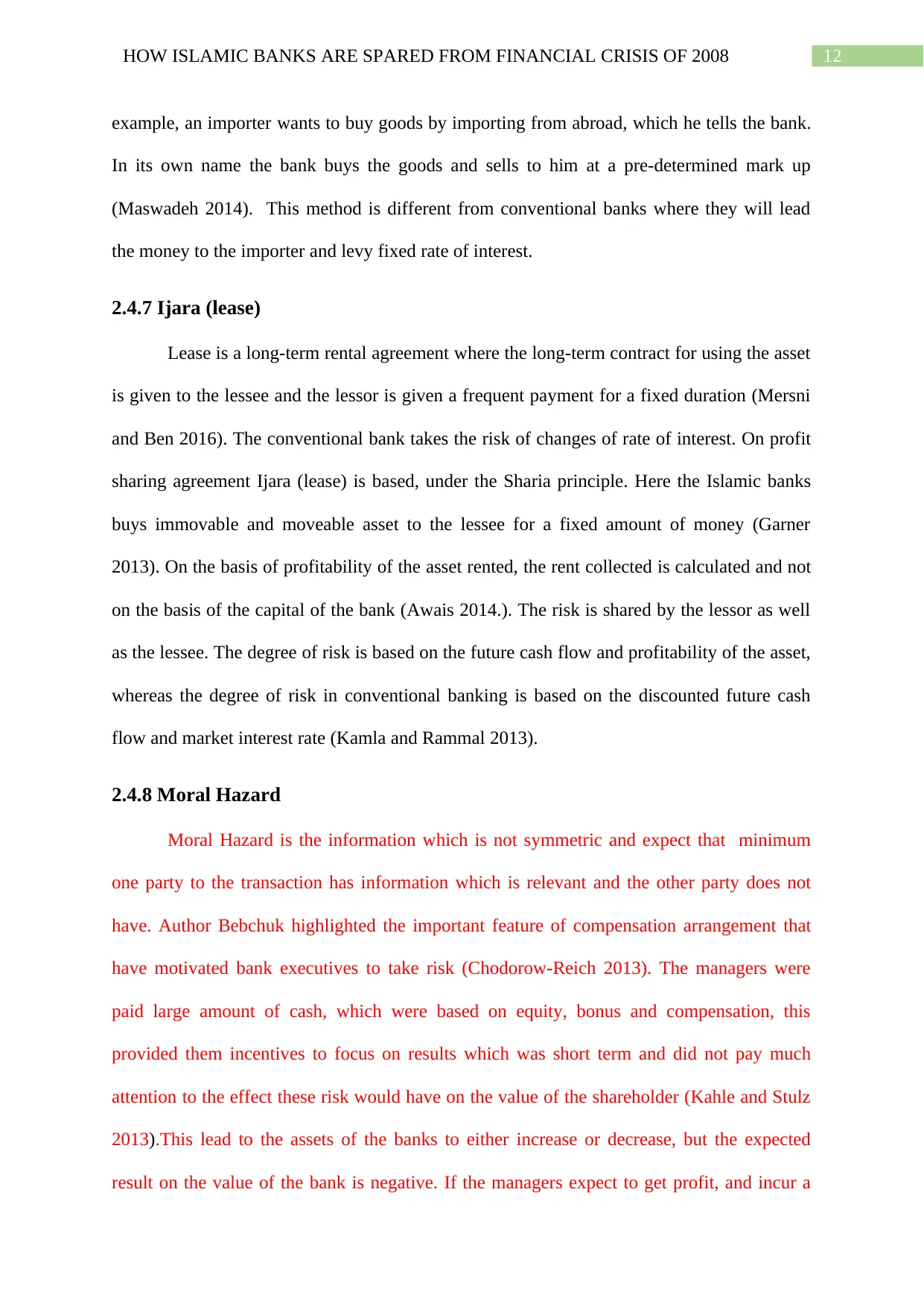
12HOW ISLAMIC BANKS ARE SPARED FROM FINANCIAL CRISIS OF 2008
example, an importer wants to buy goods by importing from abroad, which he tells the bank.
In its own name the bank buys the goods and sells to him at a pre-determined mark up
(Maswadeh 2014). This method is different from conventional banks where they will lead
the money to the importer and levy fixed rate of interest.
2.4.7 Ijara (lease)
Lease is a long-term rental agreement where the long-term contract for using the asset
is given to the lessee and the lessor is given a frequent payment for a fixed duration (Mersni
and Ben 2016). The conventional bank takes the risk of changes of rate of interest. On profit
sharing agreement Ijara (lease) is based, under the Sharia principle. Here the Islamic banks
buys immovable and moveable asset to the lessee for a fixed amount of money (Garner
2013). On the basis of profitability of the asset rented, the rent collected is calculated and not
on the basis of the capital of the bank (Awais 2014.). The risk is shared by the lessor as well
as the lessee. The degree of risk is based on the future cash flow and profitability of the asset,
whereas the degree of risk in conventional banking is based on the discounted future cash
flow and market interest rate (Kamla and Rammal 2013).
2.4.8 Moral Hazard
Moral Hazard is the information which is not symmetric and expect that minimum
one party to the transaction has information which is relevant and the other party does not
have. Author Bebchuk highlighted the important feature of compensation arrangement that
have motivated bank executives to take risk (Chodorow-Reich 2013). The managers were
paid large amount of cash, which were based on equity, bonus and compensation, this
provided them incentives to focus on results which was short term and did not pay much
attention to the effect these risk would have on the value of the shareholder (Kahle and Stulz
2013).This lead to the assets of the banks to either increase or decrease, but the expected
result on the value of the bank is negative. If the managers expect to get profit, and incur a
example, an importer wants to buy goods by importing from abroad, which he tells the bank.
In its own name the bank buys the goods and sells to him at a pre-determined mark up
(Maswadeh 2014). This method is different from conventional banks where they will lead
the money to the importer and levy fixed rate of interest.
2.4.7 Ijara (lease)
Lease is a long-term rental agreement where the long-term contract for using the asset
is given to the lessee and the lessor is given a frequent payment for a fixed duration (Mersni
and Ben 2016). The conventional bank takes the risk of changes of rate of interest. On profit
sharing agreement Ijara (lease) is based, under the Sharia principle. Here the Islamic banks
buys immovable and moveable asset to the lessee for a fixed amount of money (Garner
2013). On the basis of profitability of the asset rented, the rent collected is calculated and not
on the basis of the capital of the bank (Awais 2014.). The risk is shared by the lessor as well
as the lessee. The degree of risk is based on the future cash flow and profitability of the asset,
whereas the degree of risk in conventional banking is based on the discounted future cash
flow and market interest rate (Kamla and Rammal 2013).
2.4.8 Moral Hazard
Moral Hazard is the information which is not symmetric and expect that minimum
one party to the transaction has information which is relevant and the other party does not
have. Author Bebchuk highlighted the important feature of compensation arrangement that
have motivated bank executives to take risk (Chodorow-Reich 2013). The managers were
paid large amount of cash, which were based on equity, bonus and compensation, this
provided them incentives to focus on results which was short term and did not pay much
attention to the effect these risk would have on the value of the shareholder (Kahle and Stulz
2013).This lead to the assets of the banks to either increase or decrease, but the expected
result on the value of the bank is negative. If the managers expect to get profit, and incur a
Paraphrase This Document
Need a fresh take? Get an instant paraphrase of this document with our AI Paraphraser
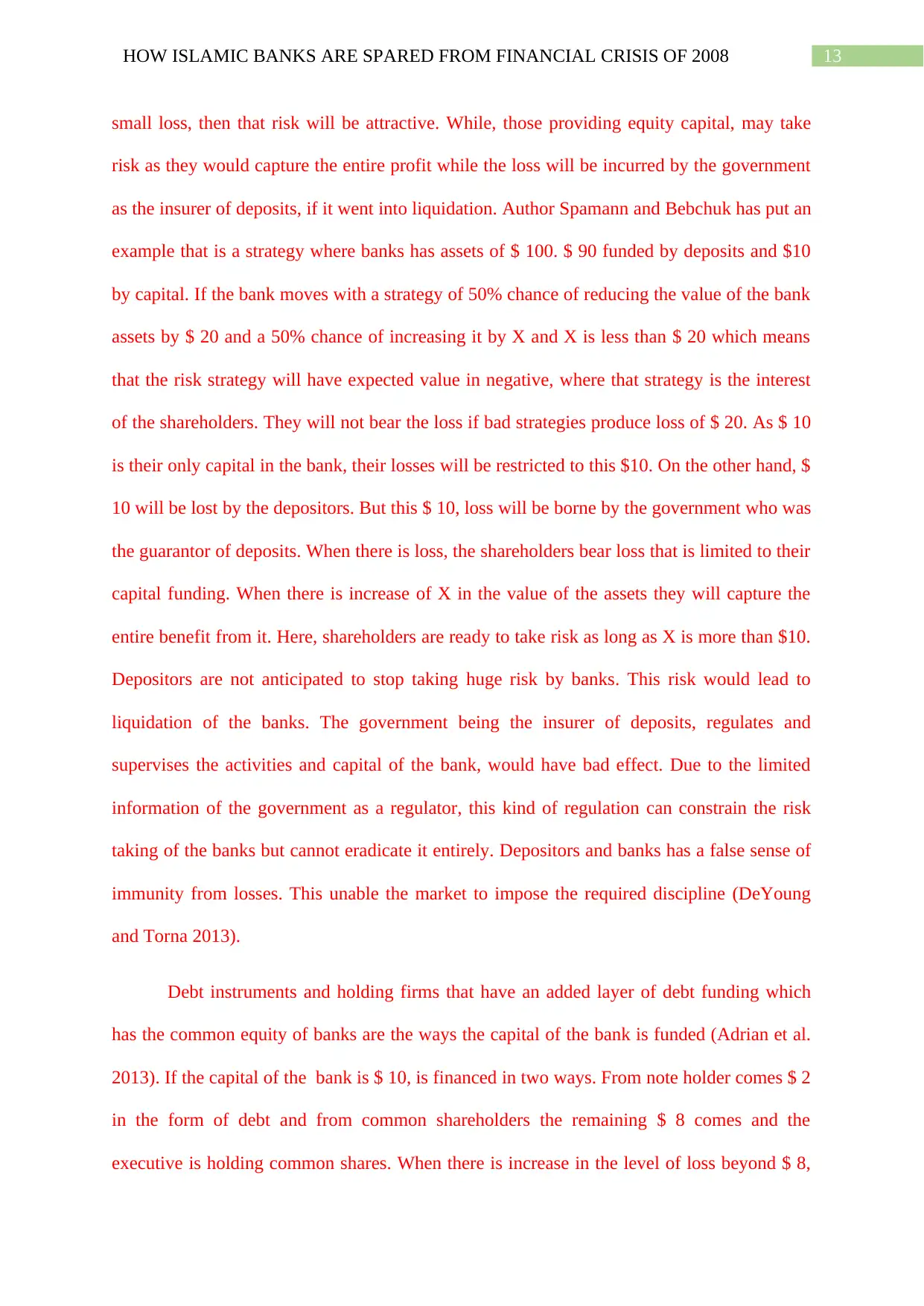
13HOW ISLAMIC BANKS ARE SPARED FROM FINANCIAL CRISIS OF 2008
small loss, then that risk will be attractive. While, those providing equity capital, may take
risk as they would capture the entire profit while the loss will be incurred by the government
as the insurer of deposits, if it went into liquidation. Author Spamann and Bebchuk has put an
example that is a strategy where banks has assets of $ 100. $ 90 funded by deposits and $10
by capital. If the bank moves with a strategy of 50% chance of reducing the value of the bank
assets by $ 20 and a 50% chance of increasing it by X and X is less than $ 20 which means
that the risk strategy will have expected value in negative, where that strategy is the interest
of the shareholders. They will not bear the loss if bad strategies produce loss of $ 20. As $ 10
is their only capital in the bank, their losses will be restricted to this $10. On the other hand, $
10 will be lost by the depositors. But this $ 10, loss will be borne by the government who was
the guarantor of deposits. When there is loss, the shareholders bear loss that is limited to their
capital funding. When there is increase of X in the value of the assets they will capture the
entire benefit from it. Here, shareholders are ready to take risk as long as X is more than $10.
Depositors are not anticipated to stop taking huge risk by banks. This risk would lead to
liquidation of the banks. The government being the insurer of deposits, regulates and
supervises the activities and capital of the bank, would have bad effect. Due to the limited
information of the government as a regulator, this kind of regulation can constrain the risk
taking of the banks but cannot eradicate it entirely. Depositors and banks has a false sense of
immunity from losses. This unable the market to impose the required discipline (DeYoung
and Torna 2013).
Debt instruments and holding firms that have an added layer of debt funding which
has the common equity of banks are the ways the capital of the bank is funded (Adrian et al.
2013). If the capital of the bank is $ 10, is financed in two ways. From note holder comes $ 2
in the form of debt and from common shareholders the remaining $ 8 comes and the
executive is holding common shares. When there is increase in the level of loss beyond $ 8,
small loss, then that risk will be attractive. While, those providing equity capital, may take
risk as they would capture the entire profit while the loss will be incurred by the government
as the insurer of deposits, if it went into liquidation. Author Spamann and Bebchuk has put an
example that is a strategy where banks has assets of $ 100. $ 90 funded by deposits and $10
by capital. If the bank moves with a strategy of 50% chance of reducing the value of the bank
assets by $ 20 and a 50% chance of increasing it by X and X is less than $ 20 which means
that the risk strategy will have expected value in negative, where that strategy is the interest
of the shareholders. They will not bear the loss if bad strategies produce loss of $ 20. As $ 10
is their only capital in the bank, their losses will be restricted to this $10. On the other hand, $
10 will be lost by the depositors. But this $ 10, loss will be borne by the government who was
the guarantor of deposits. When there is loss, the shareholders bear loss that is limited to their
capital funding. When there is increase of X in the value of the assets they will capture the
entire benefit from it. Here, shareholders are ready to take risk as long as X is more than $10.
Depositors are not anticipated to stop taking huge risk by banks. This risk would lead to
liquidation of the banks. The government being the insurer of deposits, regulates and
supervises the activities and capital of the bank, would have bad effect. Due to the limited
information of the government as a regulator, this kind of regulation can constrain the risk
taking of the banks but cannot eradicate it entirely. Depositors and banks has a false sense of
immunity from losses. This unable the market to impose the required discipline (DeYoung
and Torna 2013).
Debt instruments and holding firms that have an added layer of debt funding which
has the common equity of banks are the ways the capital of the bank is funded (Adrian et al.
2013). If the capital of the bank is $ 10, is financed in two ways. From note holder comes $ 2
in the form of debt and from common shareholders the remaining $ 8 comes and the
executive is holding common shares. When there is increase in the level of loss beyond $ 8,
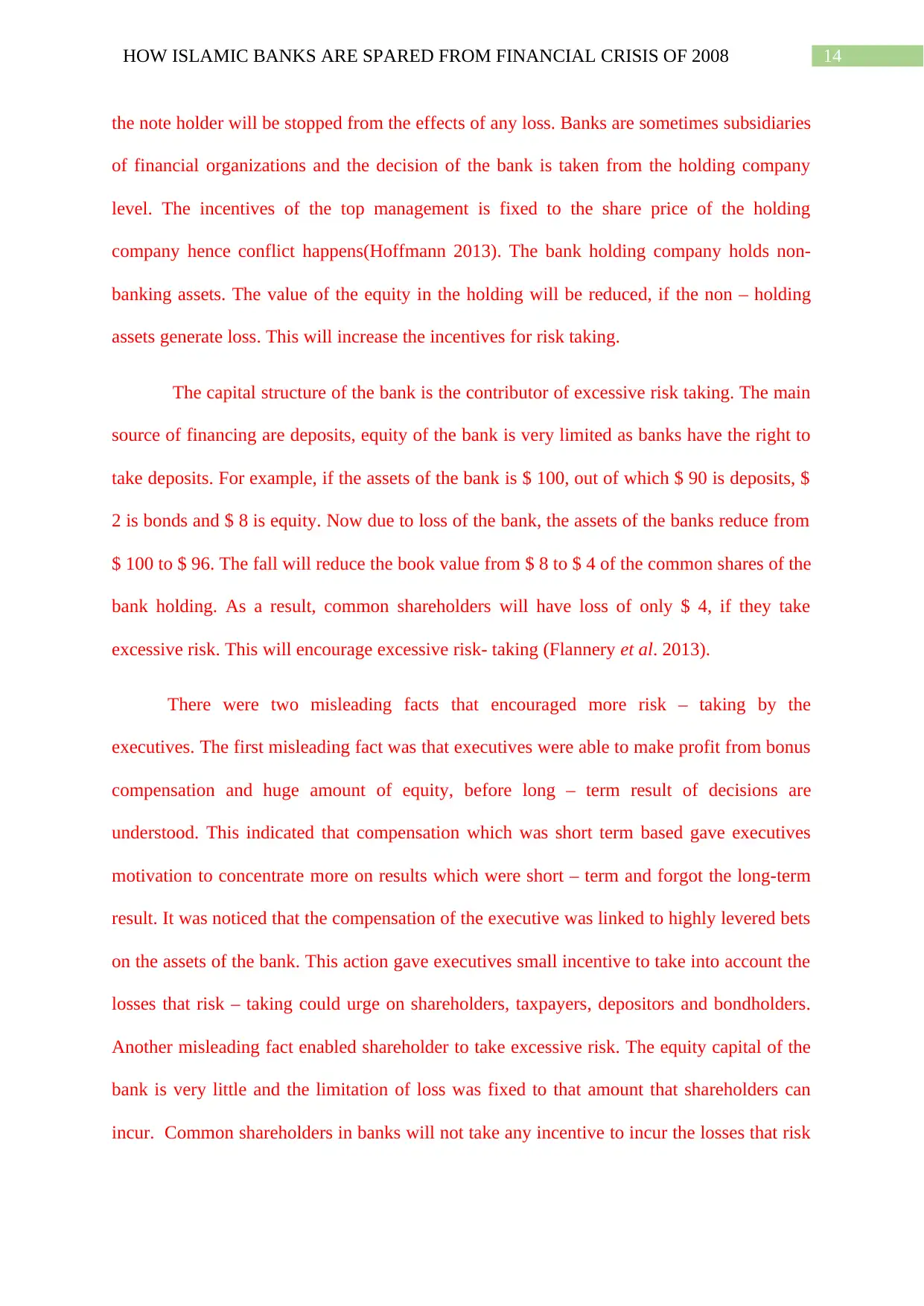
14HOW ISLAMIC BANKS ARE SPARED FROM FINANCIAL CRISIS OF 2008
the note holder will be stopped from the effects of any loss. Banks are sometimes subsidiaries
of financial organizations and the decision of the bank is taken from the holding company
level. The incentives of the top management is fixed to the share price of the holding
company hence conflict happens(Hoffmann 2013). The bank holding company holds non-
banking assets. The value of the equity in the holding will be reduced, if the non – holding
assets generate loss. This will increase the incentives for risk taking.
The capital structure of the bank is the contributor of excessive risk taking. The main
source of financing are deposits, equity of the bank is very limited as banks have the right to
take deposits. For example, if the assets of the bank is $ 100, out of which $ 90 is deposits, $
2 is bonds and $ 8 is equity. Now due to loss of the bank, the assets of the banks reduce from
$ 100 to $ 96. The fall will reduce the book value from $ 8 to $ 4 of the common shares of the
bank holding. As a result, common shareholders will have loss of only $ 4, if they take
excessive risk. This will encourage excessive risk- taking (Flannery et al. 2013).
There were two misleading facts that encouraged more risk – taking by the
executives. The first misleading fact was that executives were able to make profit from bonus
compensation and huge amount of equity, before long – term result of decisions are
understood. This indicated that compensation which was short term based gave executives
motivation to concentrate more on results which were short – term and forgot the long-term
result. It was noticed that the compensation of the executive was linked to highly levered bets
on the assets of the bank. This action gave executives small incentive to take into account the
losses that risk – taking could urge on shareholders, taxpayers, depositors and bondholders.
Another misleading fact enabled shareholder to take excessive risk. The equity capital of the
bank is very little and the limitation of loss was fixed to that amount that shareholders can
incur. Common shareholders in banks will not take any incentive to incur the losses that risk
the note holder will be stopped from the effects of any loss. Banks are sometimes subsidiaries
of financial organizations and the decision of the bank is taken from the holding company
level. The incentives of the top management is fixed to the share price of the holding
company hence conflict happens(Hoffmann 2013). The bank holding company holds non-
banking assets. The value of the equity in the holding will be reduced, if the non – holding
assets generate loss. This will increase the incentives for risk taking.
The capital structure of the bank is the contributor of excessive risk taking. The main
source of financing are deposits, equity of the bank is very limited as banks have the right to
take deposits. For example, if the assets of the bank is $ 100, out of which $ 90 is deposits, $
2 is bonds and $ 8 is equity. Now due to loss of the bank, the assets of the banks reduce from
$ 100 to $ 96. The fall will reduce the book value from $ 8 to $ 4 of the common shares of the
bank holding. As a result, common shareholders will have loss of only $ 4, if they take
excessive risk. This will encourage excessive risk- taking (Flannery et al. 2013).
There were two misleading facts that encouraged more risk – taking by the
executives. The first misleading fact was that executives were able to make profit from bonus
compensation and huge amount of equity, before long – term result of decisions are
understood. This indicated that compensation which was short term based gave executives
motivation to concentrate more on results which were short – term and forgot the long-term
result. It was noticed that the compensation of the executive was linked to highly levered bets
on the assets of the bank. This action gave executives small incentive to take into account the
losses that risk – taking could urge on shareholders, taxpayers, depositors and bondholders.
Another misleading fact enabled shareholder to take excessive risk. The equity capital of the
bank is very little and the limitation of loss was fixed to that amount that shareholders can
incur. Common shareholders in banks will not take any incentive to incur the losses that risk
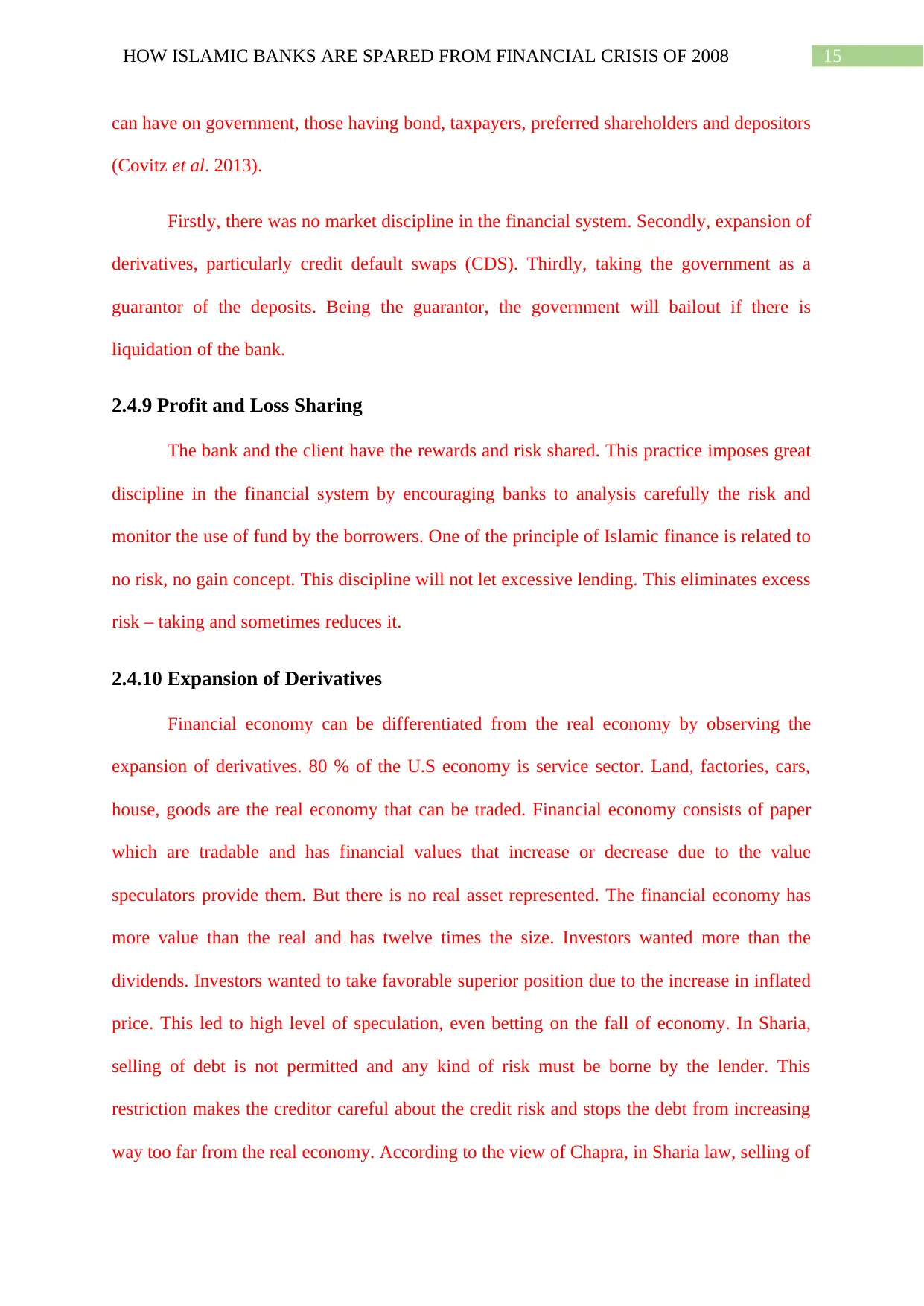
15HOW ISLAMIC BANKS ARE SPARED FROM FINANCIAL CRISIS OF 2008
can have on government, those having bond, taxpayers, preferred shareholders and depositors
(Covitz et al. 2013).
Firstly, there was no market discipline in the financial system. Secondly, expansion of
derivatives, particularly credit default swaps (CDS). Thirdly, taking the government as a
guarantor of the deposits. Being the guarantor, the government will bailout if there is
liquidation of the bank.
2.4.9 Profit and Loss Sharing
The bank and the client have the rewards and risk shared. This practice imposes great
discipline in the financial system by encouraging banks to analysis carefully the risk and
monitor the use of fund by the borrowers. One of the principle of Islamic finance is related to
no risk, no gain concept. This discipline will not let excessive lending. This eliminates excess
risk – taking and sometimes reduces it.
2.4.10 Expansion of Derivatives
Financial economy can be differentiated from the real economy by observing the
expansion of derivatives. 80 % of the U.S economy is service sector. Land, factories, cars,
house, goods are the real economy that can be traded. Financial economy consists of paper
which are tradable and has financial values that increase or decrease due to the value
speculators provide them. But there is no real asset represented. The financial economy has
more value than the real and has twelve times the size. Investors wanted more than the
dividends. Investors wanted to take favorable superior position due to the increase in inflated
price. This led to high level of speculation, even betting on the fall of economy. In Sharia,
selling of debt is not permitted and any kind of risk must be borne by the lender. This
restriction makes the creditor careful about the credit risk and stops the debt from increasing
way too far from the real economy. According to the view of Chapra, in Sharia law, selling of
can have on government, those having bond, taxpayers, preferred shareholders and depositors
(Covitz et al. 2013).
Firstly, there was no market discipline in the financial system. Secondly, expansion of
derivatives, particularly credit default swaps (CDS). Thirdly, taking the government as a
guarantor of the deposits. Being the guarantor, the government will bailout if there is
liquidation of the bank.
2.4.9 Profit and Loss Sharing
The bank and the client have the rewards and risk shared. This practice imposes great
discipline in the financial system by encouraging banks to analysis carefully the risk and
monitor the use of fund by the borrowers. One of the principle of Islamic finance is related to
no risk, no gain concept. This discipline will not let excessive lending. This eliminates excess
risk – taking and sometimes reduces it.
2.4.10 Expansion of Derivatives
Financial economy can be differentiated from the real economy by observing the
expansion of derivatives. 80 % of the U.S economy is service sector. Land, factories, cars,
house, goods are the real economy that can be traded. Financial economy consists of paper
which are tradable and has financial values that increase or decrease due to the value
speculators provide them. But there is no real asset represented. The financial economy has
more value than the real and has twelve times the size. Investors wanted more than the
dividends. Investors wanted to take favorable superior position due to the increase in inflated
price. This led to high level of speculation, even betting on the fall of economy. In Sharia,
selling of debt is not permitted and any kind of risk must be borne by the lender. This
restriction makes the creditor careful about the credit risk and stops the debt from increasing
way too far from the real economy. According to the view of Chapra, in Sharia law, selling of
Secure Best Marks with AI Grader
Need help grading? Try our AI Grader for instant feedback on your assignments.
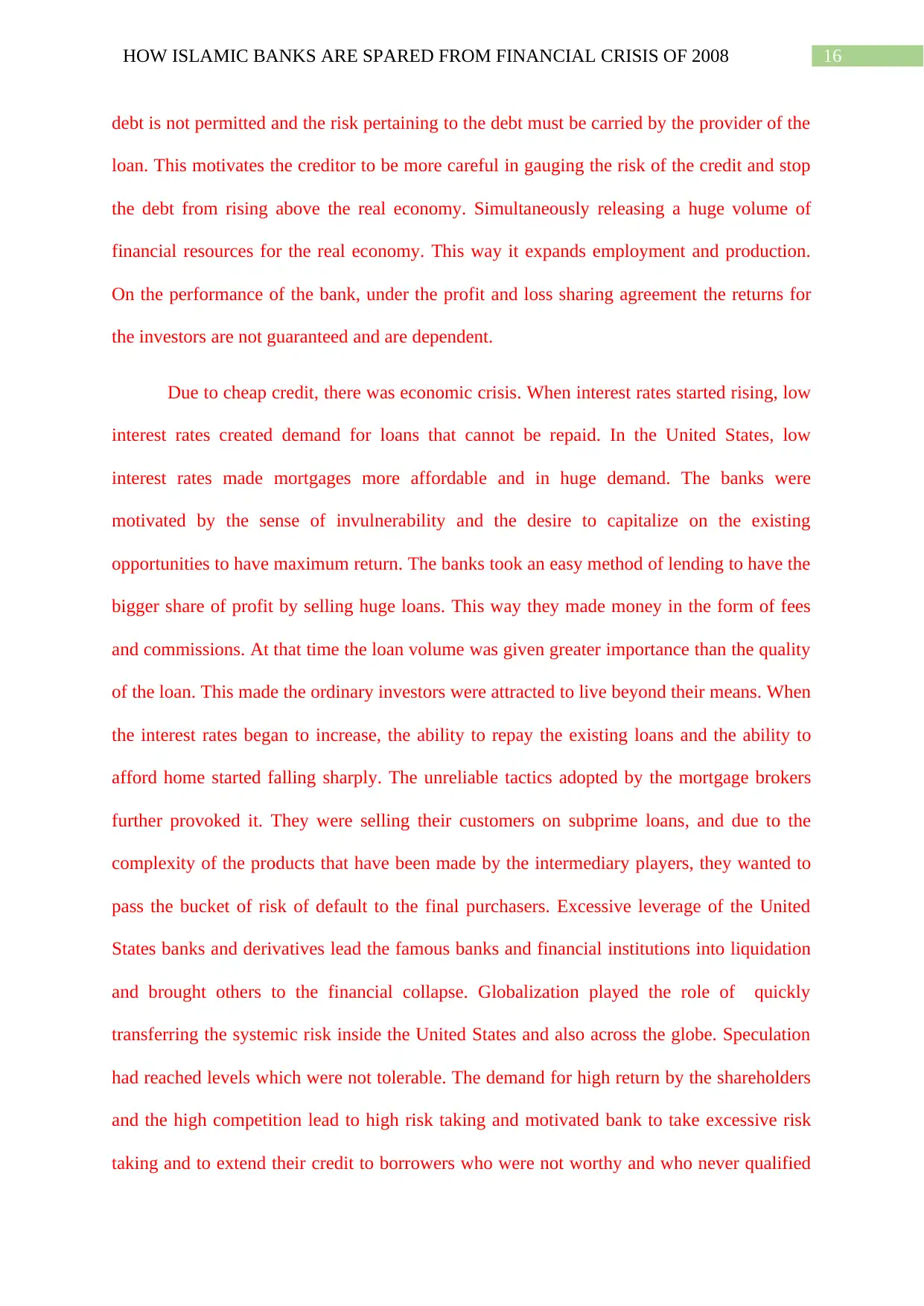
16HOW ISLAMIC BANKS ARE SPARED FROM FINANCIAL CRISIS OF 2008
debt is not permitted and the risk pertaining to the debt must be carried by the provider of the
loan. This motivates the creditor to be more careful in gauging the risk of the credit and stop
the debt from rising above the real economy. Simultaneously releasing a huge volume of
financial resources for the real economy. This way it expands employment and production.
On the performance of the bank, under the profit and loss sharing agreement the returns for
the investors are not guaranteed and are dependent.
Due to cheap credit, there was economic crisis. When interest rates started rising, low
interest rates created demand for loans that cannot be repaid. In the United States, low
interest rates made mortgages more affordable and in huge demand. The banks were
motivated by the sense of invulnerability and the desire to capitalize on the existing
opportunities to have maximum return. The banks took an easy method of lending to have the
bigger share of profit by selling huge loans. This way they made money in the form of fees
and commissions. At that time the loan volume was given greater importance than the quality
of the loan. This made the ordinary investors were attracted to live beyond their means. When
the interest rates began to increase, the ability to repay the existing loans and the ability to
afford home started falling sharply. The unreliable tactics adopted by the mortgage brokers
further provoked it. They were selling their customers on subprime loans, and due to the
complexity of the products that have been made by the intermediary players, they wanted to
pass the bucket of risk of default to the final purchasers. Excessive leverage of the United
States banks and derivatives lead the famous banks and financial institutions into liquidation
and brought others to the financial collapse. Globalization played the role of quickly
transferring the systemic risk inside the United States and also across the globe. Speculation
had reached levels which were not tolerable. The demand for high return by the shareholders
and the high competition lead to high risk taking and motivated bank to take excessive risk
taking and to extend their credit to borrowers who were not worthy and who never qualified
debt is not permitted and the risk pertaining to the debt must be carried by the provider of the
loan. This motivates the creditor to be more careful in gauging the risk of the credit and stop
the debt from rising above the real economy. Simultaneously releasing a huge volume of
financial resources for the real economy. This way it expands employment and production.
On the performance of the bank, under the profit and loss sharing agreement the returns for
the investors are not guaranteed and are dependent.
Due to cheap credit, there was economic crisis. When interest rates started rising, low
interest rates created demand for loans that cannot be repaid. In the United States, low
interest rates made mortgages more affordable and in huge demand. The banks were
motivated by the sense of invulnerability and the desire to capitalize on the existing
opportunities to have maximum return. The banks took an easy method of lending to have the
bigger share of profit by selling huge loans. This way they made money in the form of fees
and commissions. At that time the loan volume was given greater importance than the quality
of the loan. This made the ordinary investors were attracted to live beyond their means. When
the interest rates began to increase, the ability to repay the existing loans and the ability to
afford home started falling sharply. The unreliable tactics adopted by the mortgage brokers
further provoked it. They were selling their customers on subprime loans, and due to the
complexity of the products that have been made by the intermediary players, they wanted to
pass the bucket of risk of default to the final purchasers. Excessive leverage of the United
States banks and derivatives lead the famous banks and financial institutions into liquidation
and brought others to the financial collapse. Globalization played the role of quickly
transferring the systemic risk inside the United States and also across the globe. Speculation
had reached levels which were not tolerable. The demand for high return by the shareholders
and the high competition lead to high risk taking and motivated bank to take excessive risk
taking and to extend their credit to borrowers who were not worthy and who never qualified
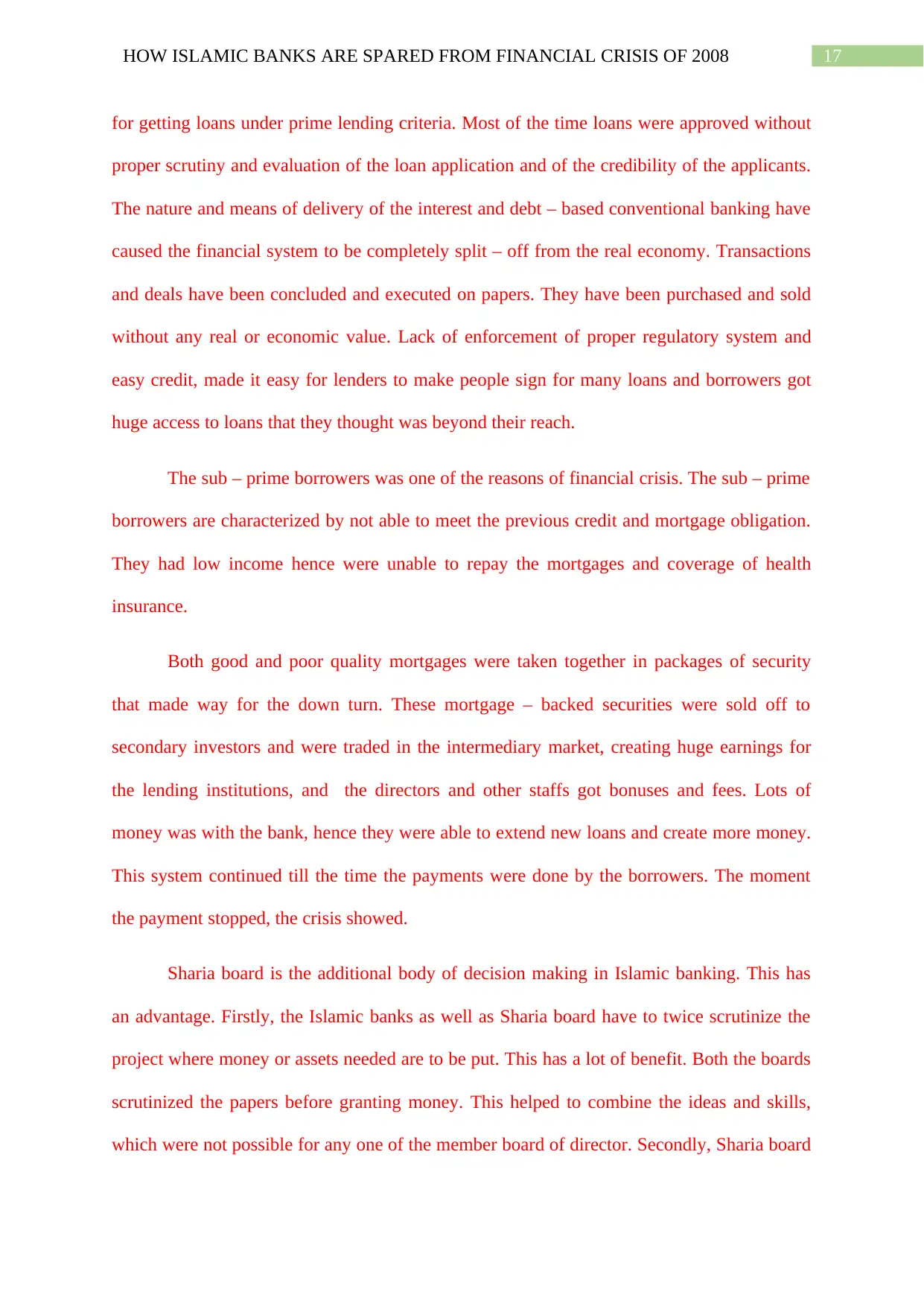
17HOW ISLAMIC BANKS ARE SPARED FROM FINANCIAL CRISIS OF 2008
for getting loans under prime lending criteria. Most of the time loans were approved without
proper scrutiny and evaluation of the loan application and of the credibility of the applicants.
The nature and means of delivery of the interest and debt – based conventional banking have
caused the financial system to be completely split – off from the real economy. Transactions
and deals have been concluded and executed on papers. They have been purchased and sold
without any real or economic value. Lack of enforcement of proper regulatory system and
easy credit, made it easy for lenders to make people sign for many loans and borrowers got
huge access to loans that they thought was beyond their reach.
The sub – prime borrowers was one of the reasons of financial crisis. The sub – prime
borrowers are characterized by not able to meet the previous credit and mortgage obligation.
They had low income hence were unable to repay the mortgages and coverage of health
insurance.
Both good and poor quality mortgages were taken together in packages of security
that made way for the down turn. These mortgage – backed securities were sold off to
secondary investors and were traded in the intermediary market, creating huge earnings for
the lending institutions, and the directors and other staffs got bonuses and fees. Lots of
money was with the bank, hence they were able to extend new loans and create more money.
This system continued till the time the payments were done by the borrowers. The moment
the payment stopped, the crisis showed.
Sharia board is the additional body of decision making in Islamic banking. This has
an advantage. Firstly, the Islamic banks as well as Sharia board have to twice scrutinize the
project where money or assets needed are to be put. This has a lot of benefit. Both the boards
scrutinized the papers before granting money. This helped to combine the ideas and skills,
which were not possible for any one of the member board of director. Secondly, Sharia board
for getting loans under prime lending criteria. Most of the time loans were approved without
proper scrutiny and evaluation of the loan application and of the credibility of the applicants.
The nature and means of delivery of the interest and debt – based conventional banking have
caused the financial system to be completely split – off from the real economy. Transactions
and deals have been concluded and executed on papers. They have been purchased and sold
without any real or economic value. Lack of enforcement of proper regulatory system and
easy credit, made it easy for lenders to make people sign for many loans and borrowers got
huge access to loans that they thought was beyond their reach.
The sub – prime borrowers was one of the reasons of financial crisis. The sub – prime
borrowers are characterized by not able to meet the previous credit and mortgage obligation.
They had low income hence were unable to repay the mortgages and coverage of health
insurance.
Both good and poor quality mortgages were taken together in packages of security
that made way for the down turn. These mortgage – backed securities were sold off to
secondary investors and were traded in the intermediary market, creating huge earnings for
the lending institutions, and the directors and other staffs got bonuses and fees. Lots of
money was with the bank, hence they were able to extend new loans and create more money.
This system continued till the time the payments were done by the borrowers. The moment
the payment stopped, the crisis showed.
Sharia board is the additional body of decision making in Islamic banking. This has
an advantage. Firstly, the Islamic banks as well as Sharia board have to twice scrutinize the
project where money or assets needed are to be put. This has a lot of benefit. Both the boards
scrutinized the papers before granting money. This helped to combine the ideas and skills,
which were not possible for any one of the member board of director. Secondly, Sharia board
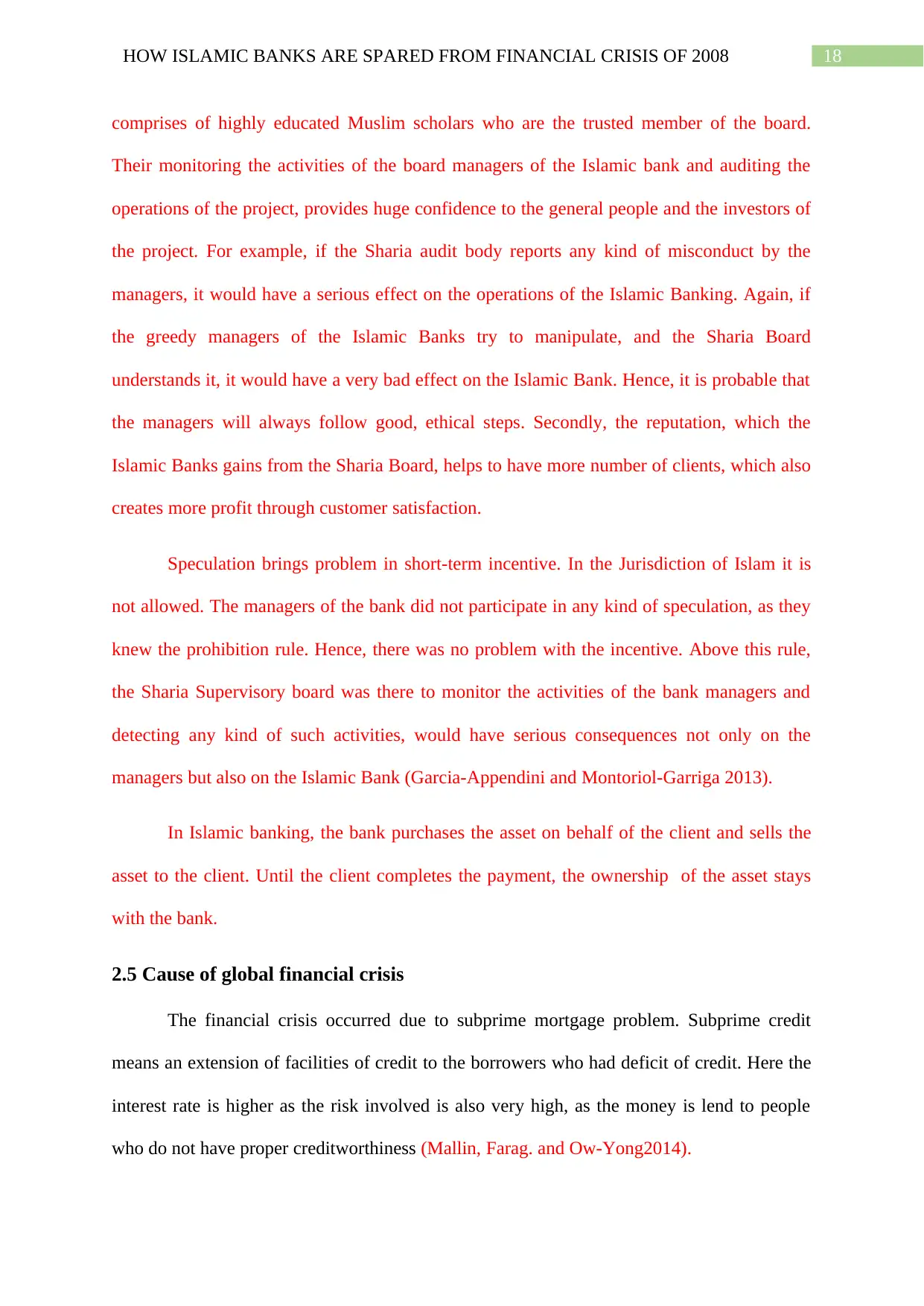
18HOW ISLAMIC BANKS ARE SPARED FROM FINANCIAL CRISIS OF 2008
comprises of highly educated Muslim scholars who are the trusted member of the board.
Their monitoring the activities of the board managers of the Islamic bank and auditing the
operations of the project, provides huge confidence to the general people and the investors of
the project. For example, if the Sharia audit body reports any kind of misconduct by the
managers, it would have a serious effect on the operations of the Islamic Banking. Again, if
the greedy managers of the Islamic Banks try to manipulate, and the Sharia Board
understands it, it would have a very bad effect on the Islamic Bank. Hence, it is probable that
the managers will always follow good, ethical steps. Secondly, the reputation, which the
Islamic Banks gains from the Sharia Board, helps to have more number of clients, which also
creates more profit through customer satisfaction.
Speculation brings problem in short-term incentive. In the Jurisdiction of Islam it is
not allowed. The managers of the bank did not participate in any kind of speculation, as they
knew the prohibition rule. Hence, there was no problem with the incentive. Above this rule,
the Sharia Supervisory board was there to monitor the activities of the bank managers and
detecting any kind of such activities, would have serious consequences not only on the
managers but also on the Islamic Bank (Garcia-Appendini and Montoriol-Garriga 2013).
In Islamic banking, the bank purchases the asset on behalf of the client and sells the
asset to the client. Until the client completes the payment, the ownership of the asset stays
with the bank.
2.5 Cause of global financial crisis
The financial crisis occurred due to subprime mortgage problem. Subprime credit
means an extension of facilities of credit to the borrowers who had deficit of credit. Here the
interest rate is higher as the risk involved is also very high, as the money is lend to people
who do not have proper creditworthiness (Mallin, Farag. and Ow-Yong2014).
comprises of highly educated Muslim scholars who are the trusted member of the board.
Their monitoring the activities of the board managers of the Islamic bank and auditing the
operations of the project, provides huge confidence to the general people and the investors of
the project. For example, if the Sharia audit body reports any kind of misconduct by the
managers, it would have a serious effect on the operations of the Islamic Banking. Again, if
the greedy managers of the Islamic Banks try to manipulate, and the Sharia Board
understands it, it would have a very bad effect on the Islamic Bank. Hence, it is probable that
the managers will always follow good, ethical steps. Secondly, the reputation, which the
Islamic Banks gains from the Sharia Board, helps to have more number of clients, which also
creates more profit through customer satisfaction.
Speculation brings problem in short-term incentive. In the Jurisdiction of Islam it is
not allowed. The managers of the bank did not participate in any kind of speculation, as they
knew the prohibition rule. Hence, there was no problem with the incentive. Above this rule,
the Sharia Supervisory board was there to monitor the activities of the bank managers and
detecting any kind of such activities, would have serious consequences not only on the
managers but also on the Islamic Bank (Garcia-Appendini and Montoriol-Garriga 2013).
In Islamic banking, the bank purchases the asset on behalf of the client and sells the
asset to the client. Until the client completes the payment, the ownership of the asset stays
with the bank.
2.5 Cause of global financial crisis
The financial crisis occurred due to subprime mortgage problem. Subprime credit
means an extension of facilities of credit to the borrowers who had deficit of credit. Here the
interest rate is higher as the risk involved is also very high, as the money is lend to people
who do not have proper creditworthiness (Mallin, Farag. and Ow-Yong2014).
Paraphrase This Document
Need a fresh take? Get an instant paraphrase of this document with our AI Paraphraser
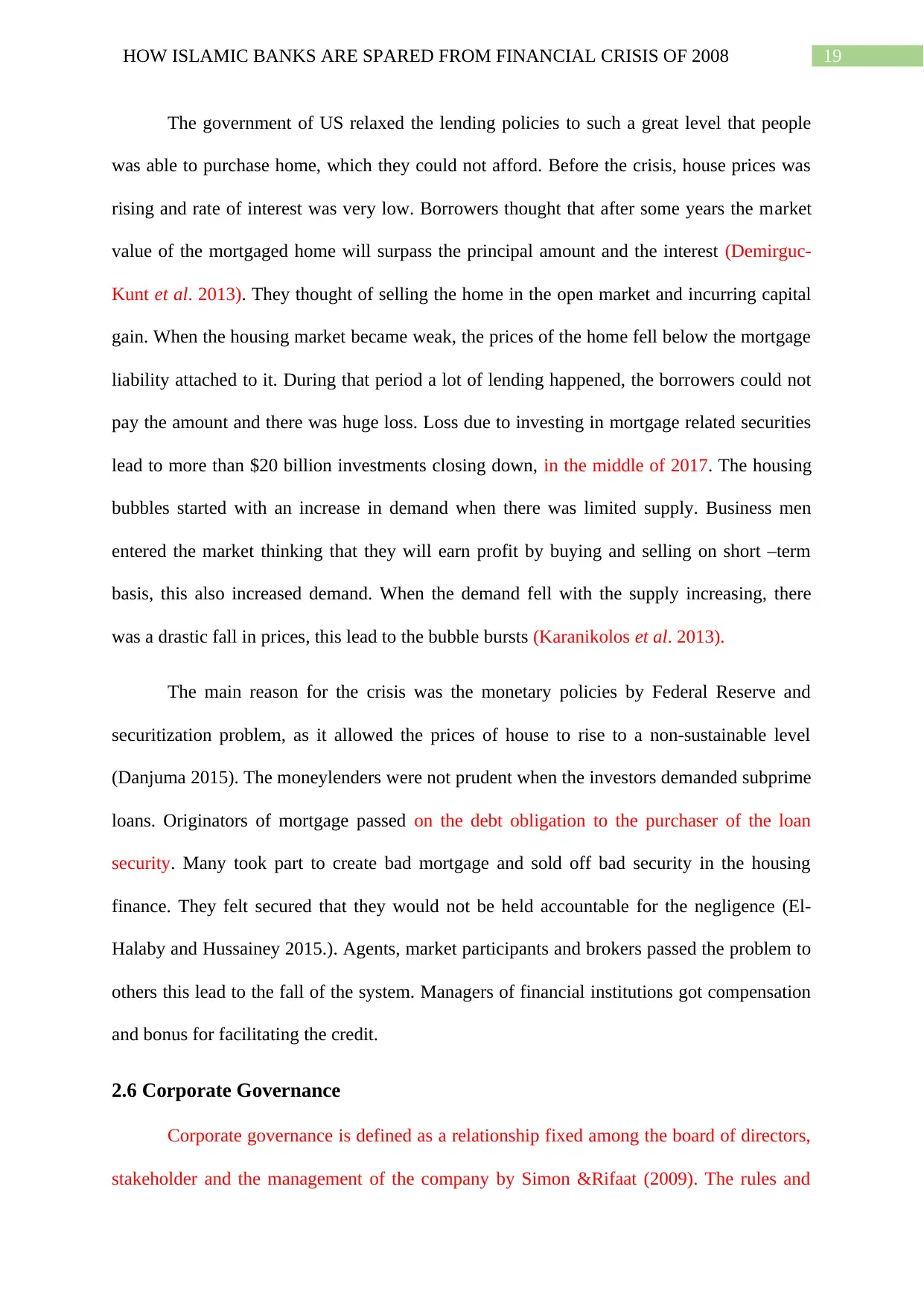
19HOW ISLAMIC BANKS ARE SPARED FROM FINANCIAL CRISIS OF 2008
The government of US relaxed the lending policies to such a great level that people
was able to purchase home, which they could not afford. Before the crisis, house prices was
rising and rate of interest was very low. Borrowers thought that after some years the market
value of the mortgaged home will surpass the principal amount and the interest (Demirguc‐
Kunt et al. 2013). They thought of selling the home in the open market and incurring capital
gain. When the housing market became weak, the prices of the home fell below the mortgage
liability attached to it. During that period a lot of lending happened, the borrowers could not
pay the amount and there was huge loss. Loss due to investing in mortgage related securities
lead to more than $20 billion investments closing down, in the middle of 2017. The housing
bubbles started with an increase in demand when there was limited supply. Business men
entered the market thinking that they will earn profit by buying and selling on short –term
basis, this also increased demand. When the demand fell with the supply increasing, there
was a drastic fall in prices, this lead to the bubble bursts (Karanikolos et al. 2013).
The main reason for the crisis was the monetary policies by Federal Reserve and
securitization problem, as it allowed the prices of house to rise to a non-sustainable level
(Danjuma 2015). The moneylenders were not prudent when the investors demanded subprime
loans. Originators of mortgage passed on the debt obligation to the purchaser of the loan
security. Many took part to create bad mortgage and sold off bad security in the housing
finance. They felt secured that they would not be held accountable for the negligence (El-
Halaby and Hussainey 2015.). Agents, market participants and brokers passed the problem to
others this lead to the fall of the system. Managers of financial institutions got compensation
and bonus for facilitating the credit.
2.6 Corporate Governance
Corporate governance is defined as a relationship fixed among the board of directors,
stakeholder and the management of the company by Simon &Rifaat (2009). The rules and
The government of US relaxed the lending policies to such a great level that people
was able to purchase home, which they could not afford. Before the crisis, house prices was
rising and rate of interest was very low. Borrowers thought that after some years the market
value of the mortgaged home will surpass the principal amount and the interest (Demirguc‐
Kunt et al. 2013). They thought of selling the home in the open market and incurring capital
gain. When the housing market became weak, the prices of the home fell below the mortgage
liability attached to it. During that period a lot of lending happened, the borrowers could not
pay the amount and there was huge loss. Loss due to investing in mortgage related securities
lead to more than $20 billion investments closing down, in the middle of 2017. The housing
bubbles started with an increase in demand when there was limited supply. Business men
entered the market thinking that they will earn profit by buying and selling on short –term
basis, this also increased demand. When the demand fell with the supply increasing, there
was a drastic fall in prices, this lead to the bubble bursts (Karanikolos et al. 2013).
The main reason for the crisis was the monetary policies by Federal Reserve and
securitization problem, as it allowed the prices of house to rise to a non-sustainable level
(Danjuma 2015). The moneylenders were not prudent when the investors demanded subprime
loans. Originators of mortgage passed on the debt obligation to the purchaser of the loan
security. Many took part to create bad mortgage and sold off bad security in the housing
finance. They felt secured that they would not be held accountable for the negligence (El-
Halaby and Hussainey 2015.). Agents, market participants and brokers passed the problem to
others this lead to the fall of the system. Managers of financial institutions got compensation
and bonus for facilitating the credit.
2.6 Corporate Governance
Corporate governance is defined as a relationship fixed among the board of directors,
stakeholder and the management of the company by Simon &Rifaat (2009). The rules and
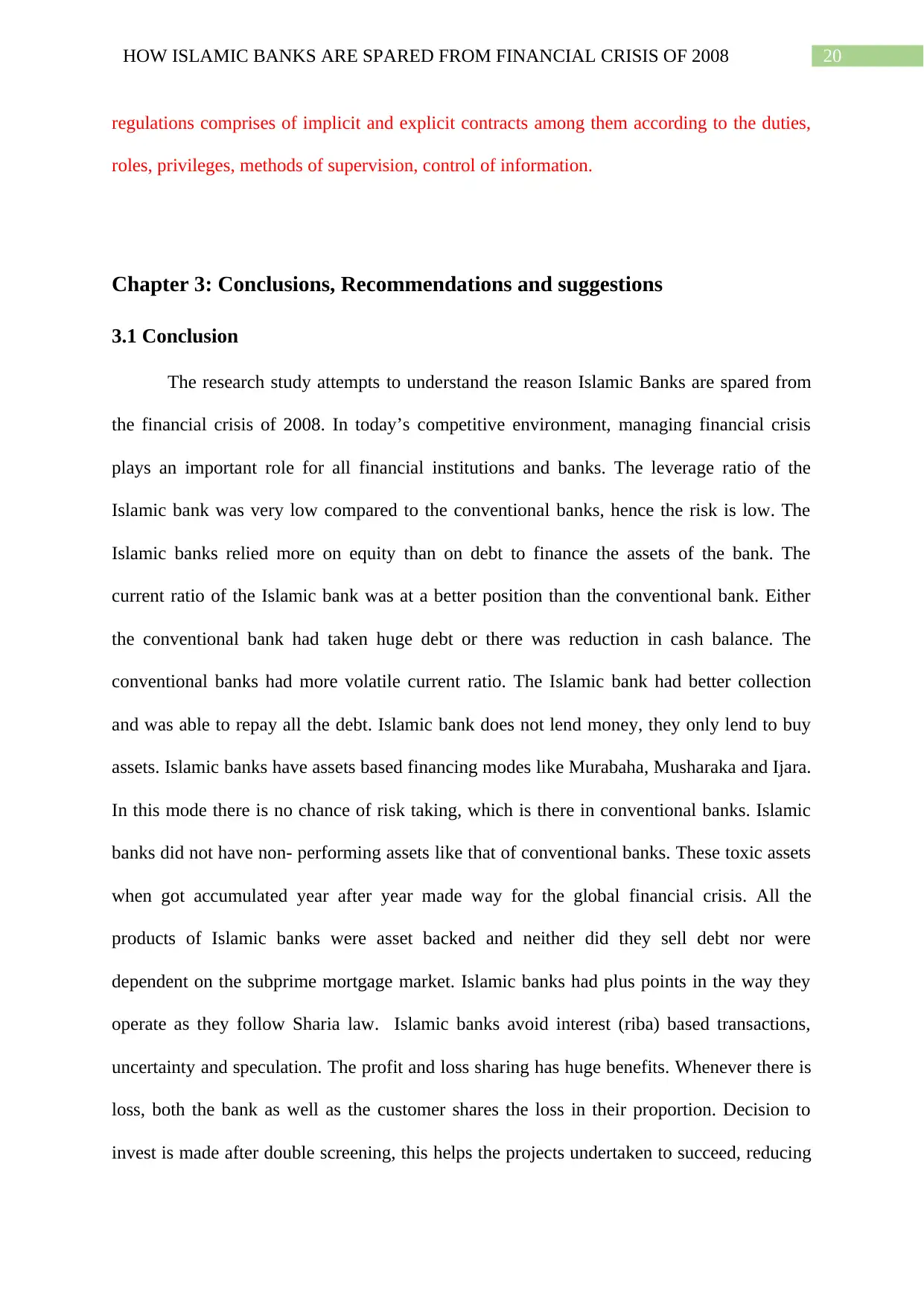
20HOW ISLAMIC BANKS ARE SPARED FROM FINANCIAL CRISIS OF 2008
regulations comprises of implicit and explicit contracts among them according to the duties,
roles, privileges, methods of supervision, control of information.
Chapter 3: Conclusions, Recommendations and suggestions
3.1 Conclusion
The research study attempts to understand the reason Islamic Banks are spared from
the financial crisis of 2008. In today’s competitive environment, managing financial crisis
plays an important role for all financial institutions and banks. The leverage ratio of the
Islamic bank was very low compared to the conventional banks, hence the risk is low. The
Islamic banks relied more on equity than on debt to finance the assets of the bank. The
current ratio of the Islamic bank was at a better position than the conventional bank. Either
the conventional bank had taken huge debt or there was reduction in cash balance. The
conventional banks had more volatile current ratio. The Islamic bank had better collection
and was able to repay all the debt. Islamic bank does not lend money, they only lend to buy
assets. Islamic banks have assets based financing modes like Murabaha, Musharaka and Ijara.
In this mode there is no chance of risk taking, which is there in conventional banks. Islamic
banks did not have non- performing assets like that of conventional banks. These toxic assets
when got accumulated year after year made way for the global financial crisis. All the
products of Islamic banks were asset backed and neither did they sell debt nor were
dependent on the subprime mortgage market. Islamic banks had plus points in the way they
operate as they follow Sharia law. Islamic banks avoid interest (riba) based transactions,
uncertainty and speculation. The profit and loss sharing has huge benefits. Whenever there is
loss, both the bank as well as the customer shares the loss in their proportion. Decision to
invest is made after double screening, this helps the projects undertaken to succeed, reducing
regulations comprises of implicit and explicit contracts among them according to the duties,
roles, privileges, methods of supervision, control of information.
Chapter 3: Conclusions, Recommendations and suggestions
3.1 Conclusion
The research study attempts to understand the reason Islamic Banks are spared from
the financial crisis of 2008. In today’s competitive environment, managing financial crisis
plays an important role for all financial institutions and banks. The leverage ratio of the
Islamic bank was very low compared to the conventional banks, hence the risk is low. The
Islamic banks relied more on equity than on debt to finance the assets of the bank. The
current ratio of the Islamic bank was at a better position than the conventional bank. Either
the conventional bank had taken huge debt or there was reduction in cash balance. The
conventional banks had more volatile current ratio. The Islamic bank had better collection
and was able to repay all the debt. Islamic bank does not lend money, they only lend to buy
assets. Islamic banks have assets based financing modes like Murabaha, Musharaka and Ijara.
In this mode there is no chance of risk taking, which is there in conventional banks. Islamic
banks did not have non- performing assets like that of conventional banks. These toxic assets
when got accumulated year after year made way for the global financial crisis. All the
products of Islamic banks were asset backed and neither did they sell debt nor were
dependent on the subprime mortgage market. Islamic banks had plus points in the way they
operate as they follow Sharia law. Islamic banks avoid interest (riba) based transactions,
uncertainty and speculation. The profit and loss sharing has huge benefits. Whenever there is
loss, both the bank as well as the customer shares the loss in their proportion. Decision to
invest is made after double screening, this helps the projects undertaken to succeed, reducing
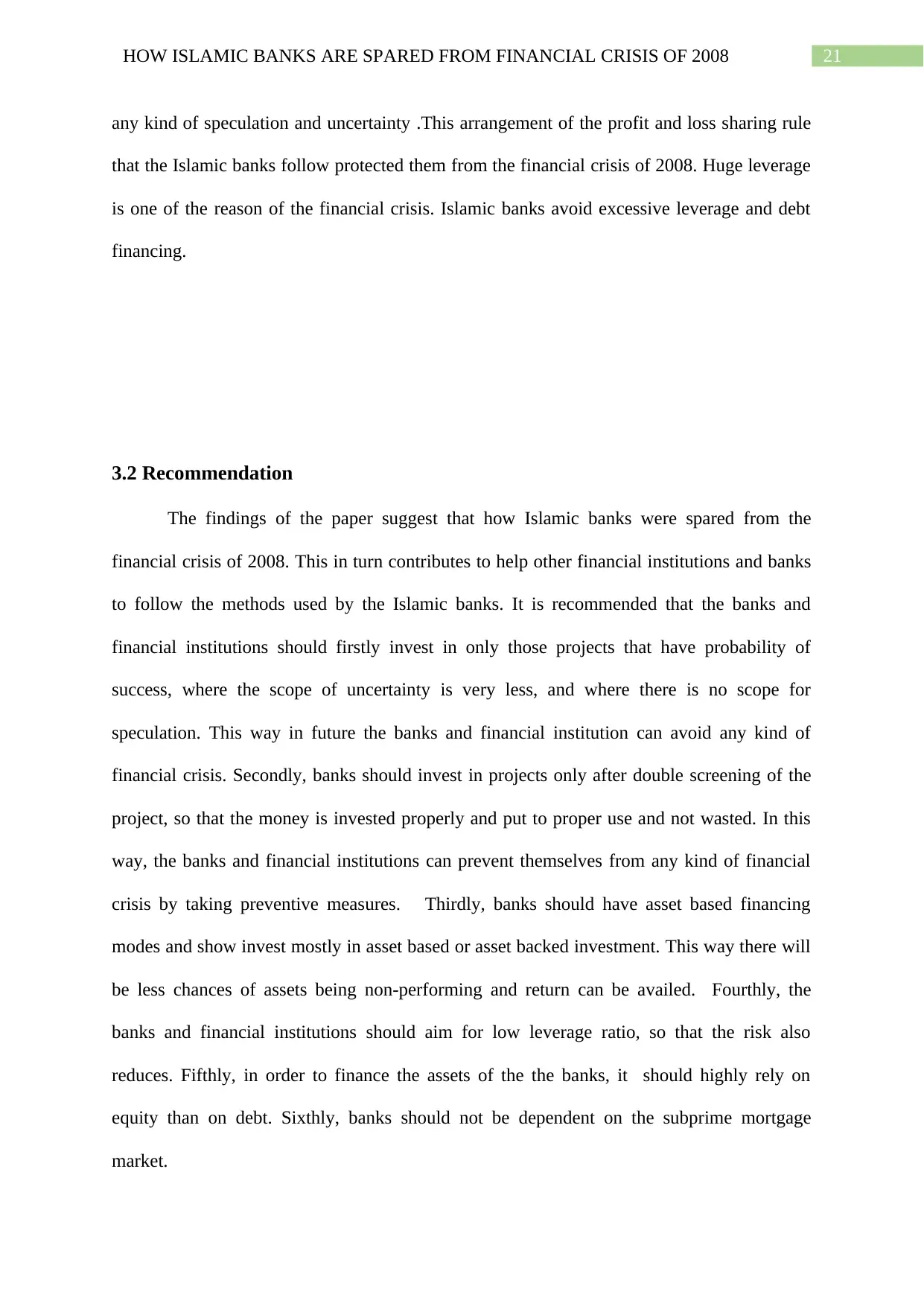
21HOW ISLAMIC BANKS ARE SPARED FROM FINANCIAL CRISIS OF 2008
any kind of speculation and uncertainty .This arrangement of the profit and loss sharing rule
that the Islamic banks follow protected them from the financial crisis of 2008. Huge leverage
is one of the reason of the financial crisis. Islamic banks avoid excessive leverage and debt
financing.
3.2 Recommendation
The findings of the paper suggest that how Islamic banks were spared from the
financial crisis of 2008. This in turn contributes to help other financial institutions and banks
to follow the methods used by the Islamic banks. It is recommended that the banks and
financial institutions should firstly invest in only those projects that have probability of
success, where the scope of uncertainty is very less, and where there is no scope for
speculation. This way in future the banks and financial institution can avoid any kind of
financial crisis. Secondly, banks should invest in projects only after double screening of the
project, so that the money is invested properly and put to proper use and not wasted. In this
way, the banks and financial institutions can prevent themselves from any kind of financial
crisis by taking preventive measures. Thirdly, banks should have asset based financing
modes and show invest mostly in asset based or asset backed investment. This way there will
be less chances of assets being non-performing and return can be availed. Fourthly, the
banks and financial institutions should aim for low leverage ratio, so that the risk also
reduces. Fifthly, in order to finance the assets of the the banks, it should highly rely on
equity than on debt. Sixthly, banks should not be dependent on the subprime mortgage
market.
any kind of speculation and uncertainty .This arrangement of the profit and loss sharing rule
that the Islamic banks follow protected them from the financial crisis of 2008. Huge leverage
is one of the reason of the financial crisis. Islamic banks avoid excessive leverage and debt
financing.
3.2 Recommendation
The findings of the paper suggest that how Islamic banks were spared from the
financial crisis of 2008. This in turn contributes to help other financial institutions and banks
to follow the methods used by the Islamic banks. It is recommended that the banks and
financial institutions should firstly invest in only those projects that have probability of
success, where the scope of uncertainty is very less, and where there is no scope for
speculation. This way in future the banks and financial institution can avoid any kind of
financial crisis. Secondly, banks should invest in projects only after double screening of the
project, so that the money is invested properly and put to proper use and not wasted. In this
way, the banks and financial institutions can prevent themselves from any kind of financial
crisis by taking preventive measures. Thirdly, banks should have asset based financing
modes and show invest mostly in asset based or asset backed investment. This way there will
be less chances of assets being non-performing and return can be availed. Fourthly, the
banks and financial institutions should aim for low leverage ratio, so that the risk also
reduces. Fifthly, in order to finance the assets of the the banks, it should highly rely on
equity than on debt. Sixthly, banks should not be dependent on the subprime mortgage
market.
Secure Best Marks with AI Grader
Need help grading? Try our AI Grader for instant feedback on your assignments.
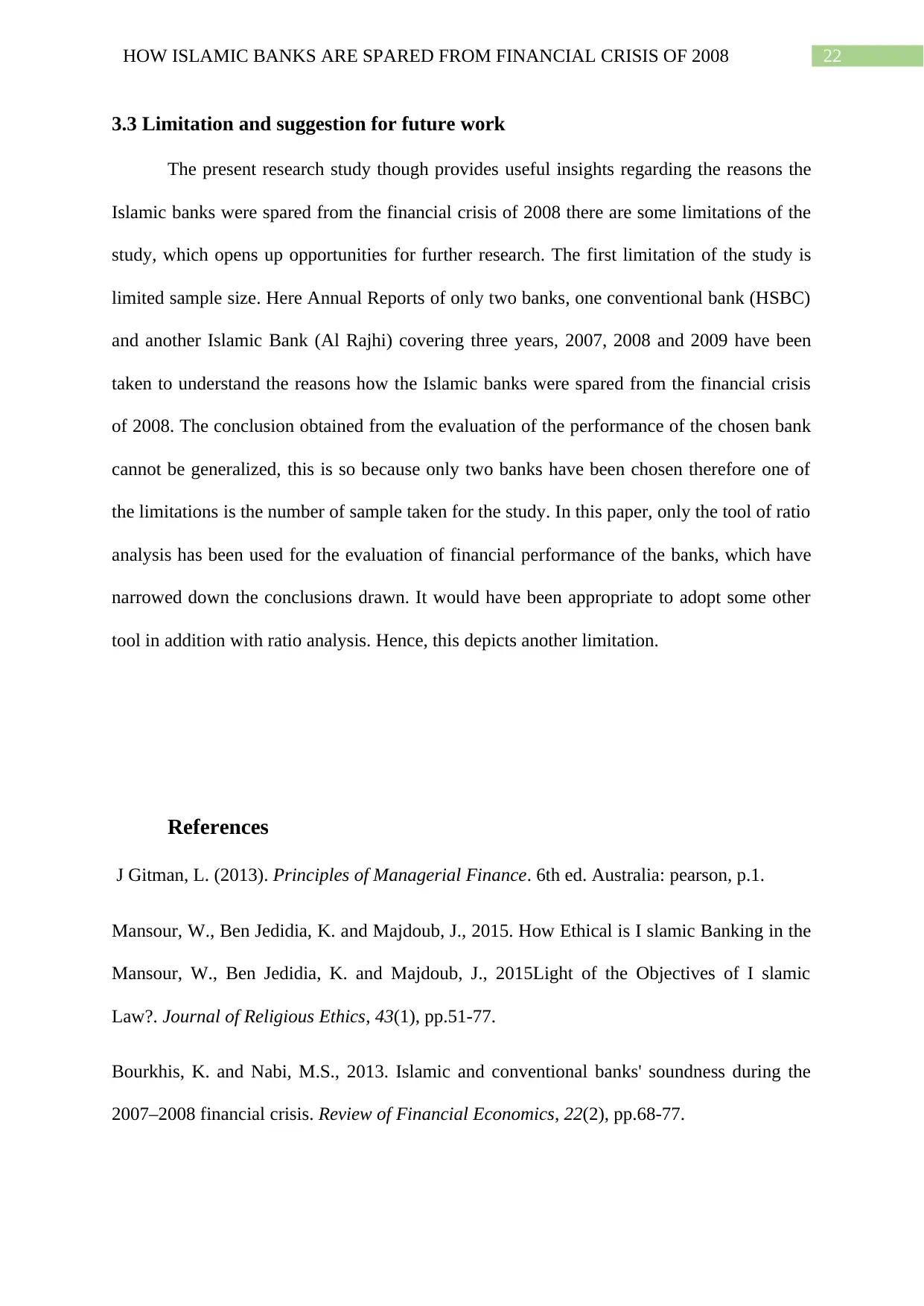
22HOW ISLAMIC BANKS ARE SPARED FROM FINANCIAL CRISIS OF 2008
3.3 Limitation and suggestion for future work
The present research study though provides useful insights regarding the reasons the
Islamic banks were spared from the financial crisis of 2008 there are some limitations of the
study, which opens up opportunities for further research. The first limitation of the study is
limited sample size. Here Annual Reports of only two banks, one conventional bank (HSBC)
and another Islamic Bank (Al Rajhi) covering three years, 2007, 2008 and 2009 have been
taken to understand the reasons how the Islamic banks were spared from the financial crisis
of 2008. The conclusion obtained from the evaluation of the performance of the chosen bank
cannot be generalized, this is so because only two banks have been chosen therefore one of
the limitations is the number of sample taken for the study. In this paper, only the tool of ratio
analysis has been used for the evaluation of financial performance of the banks, which have
narrowed down the conclusions drawn. It would have been appropriate to adopt some other
tool in addition with ratio analysis. Hence, this depicts another limitation.
References
J Gitman, L. (2013). Principles of Managerial Finance. 6th ed. Australia: pearson, p.1.
Mansour, W., Ben Jedidia, K. and Majdoub, J., 2015. How Ethical is I slamic Banking in the
Mansour, W., Ben Jedidia, K. and Majdoub, J., 2015Light of the Objectives of I slamic
Law?. Journal of Religious Ethics, 43(1), pp.51-77.
Bourkhis, K. and Nabi, M.S., 2013. Islamic and conventional banks' soundness during the
2007–2008 financial crisis. Review of Financial Economics, 22(2), pp.68-77.
3.3 Limitation and suggestion for future work
The present research study though provides useful insights regarding the reasons the
Islamic banks were spared from the financial crisis of 2008 there are some limitations of the
study, which opens up opportunities for further research. The first limitation of the study is
limited sample size. Here Annual Reports of only two banks, one conventional bank (HSBC)
and another Islamic Bank (Al Rajhi) covering three years, 2007, 2008 and 2009 have been
taken to understand the reasons how the Islamic banks were spared from the financial crisis
of 2008. The conclusion obtained from the evaluation of the performance of the chosen bank
cannot be generalized, this is so because only two banks have been chosen therefore one of
the limitations is the number of sample taken for the study. In this paper, only the tool of ratio
analysis has been used for the evaluation of financial performance of the banks, which have
narrowed down the conclusions drawn. It would have been appropriate to adopt some other
tool in addition with ratio analysis. Hence, this depicts another limitation.
References
J Gitman, L. (2013). Principles of Managerial Finance. 6th ed. Australia: pearson, p.1.
Mansour, W., Ben Jedidia, K. and Majdoub, J., 2015. How Ethical is I slamic Banking in the
Mansour, W., Ben Jedidia, K. and Majdoub, J., 2015Light of the Objectives of I slamic
Law?. Journal of Religious Ethics, 43(1), pp.51-77.
Bourkhis, K. and Nabi, M.S., 2013. Islamic and conventional banks' soundness during the
2007–2008 financial crisis. Review of Financial Economics, 22(2), pp.68-77.
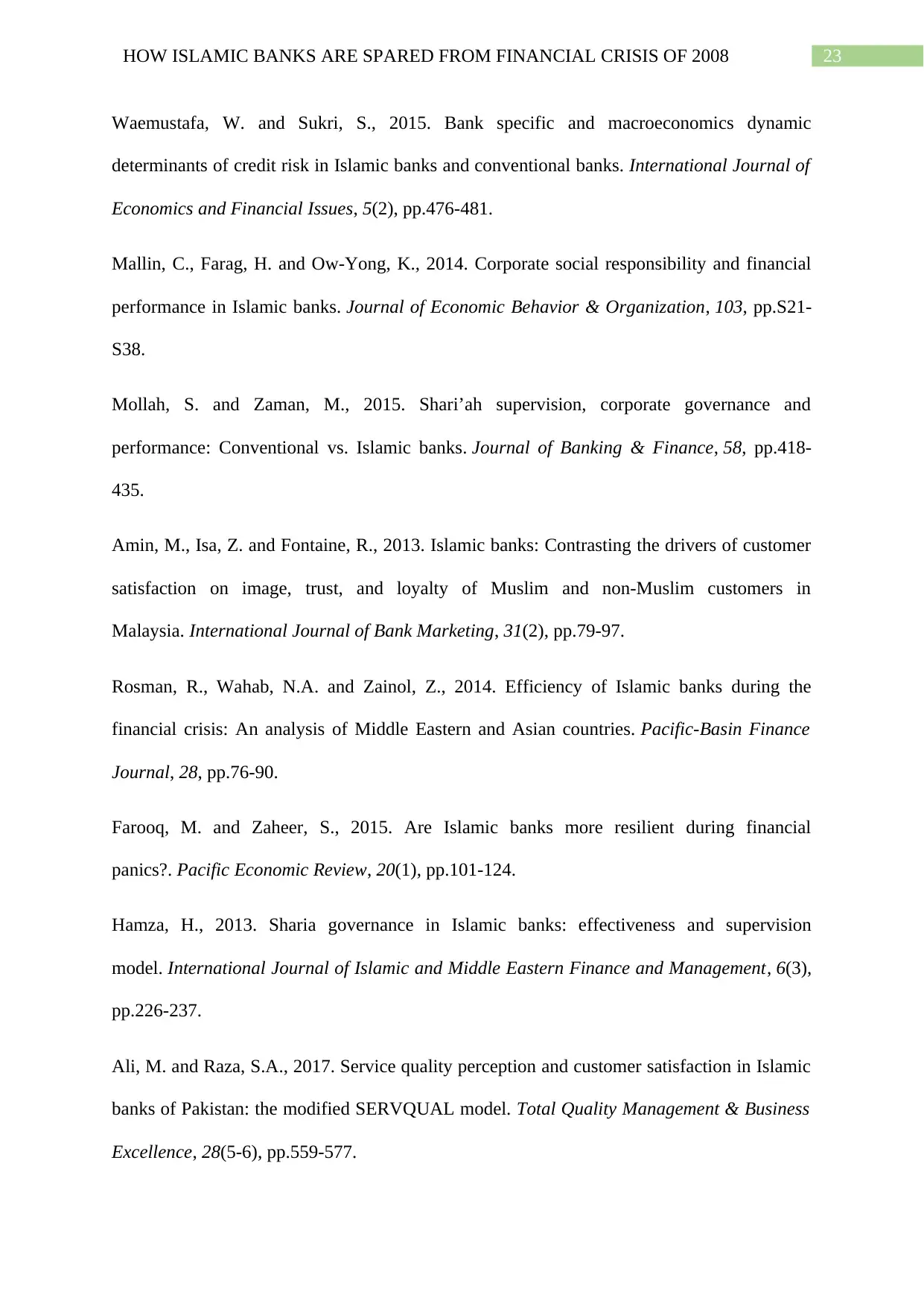
23HOW ISLAMIC BANKS ARE SPARED FROM FINANCIAL CRISIS OF 2008
Waemustafa, W. and Sukri, S., 2015. Bank specific and macroeconomics dynamic
determinants of credit risk in Islamic banks and conventional banks. International Journal of
Economics and Financial Issues, 5(2), pp.476-481.
Mallin, C., Farag, H. and Ow-Yong, K., 2014. Corporate social responsibility and financial
performance in Islamic banks. Journal of Economic Behavior & Organization, 103, pp.S21-
S38.
Mollah, S. and Zaman, M., 2015. Shari’ah supervision, corporate governance and
performance: Conventional vs. Islamic banks. Journal of Banking & Finance, 58, pp.418-
435.
Amin, M., Isa, Z. and Fontaine, R., 2013. Islamic banks: Contrasting the drivers of customer
satisfaction on image, trust, and loyalty of Muslim and non-Muslim customers in
Malaysia. International Journal of Bank Marketing, 31(2), pp.79-97.
Rosman, R., Wahab, N.A. and Zainol, Z., 2014. Efficiency of Islamic banks during the
financial crisis: An analysis of Middle Eastern and Asian countries. Pacific-Basin Finance
Journal, 28, pp.76-90.
Farooq, M. and Zaheer, S., 2015. Are Islamic banks more resilient during financial
panics?. Pacific Economic Review, 20(1), pp.101-124.
Hamza, H., 2013. Sharia governance in Islamic banks: effectiveness and supervision
model. International Journal of Islamic and Middle Eastern Finance and Management, 6(3),
pp.226-237.
Ali, M. and Raza, S.A., 2017. Service quality perception and customer satisfaction in Islamic
banks of Pakistan: the modified SERVQUAL model. Total Quality Management & Business
Excellence, 28(5-6), pp.559-577.
Waemustafa, W. and Sukri, S., 2015. Bank specific and macroeconomics dynamic
determinants of credit risk in Islamic banks and conventional banks. International Journal of
Economics and Financial Issues, 5(2), pp.476-481.
Mallin, C., Farag, H. and Ow-Yong, K., 2014. Corporate social responsibility and financial
performance in Islamic banks. Journal of Economic Behavior & Organization, 103, pp.S21-
S38.
Mollah, S. and Zaman, M., 2015. Shari’ah supervision, corporate governance and
performance: Conventional vs. Islamic banks. Journal of Banking & Finance, 58, pp.418-
435.
Amin, M., Isa, Z. and Fontaine, R., 2013. Islamic banks: Contrasting the drivers of customer
satisfaction on image, trust, and loyalty of Muslim and non-Muslim customers in
Malaysia. International Journal of Bank Marketing, 31(2), pp.79-97.
Rosman, R., Wahab, N.A. and Zainol, Z., 2014. Efficiency of Islamic banks during the
financial crisis: An analysis of Middle Eastern and Asian countries. Pacific-Basin Finance
Journal, 28, pp.76-90.
Farooq, M. and Zaheer, S., 2015. Are Islamic banks more resilient during financial
panics?. Pacific Economic Review, 20(1), pp.101-124.
Hamza, H., 2013. Sharia governance in Islamic banks: effectiveness and supervision
model. International Journal of Islamic and Middle Eastern Finance and Management, 6(3),
pp.226-237.
Ali, M. and Raza, S.A., 2017. Service quality perception and customer satisfaction in Islamic
banks of Pakistan: the modified SERVQUAL model. Total Quality Management & Business
Excellence, 28(5-6), pp.559-577.
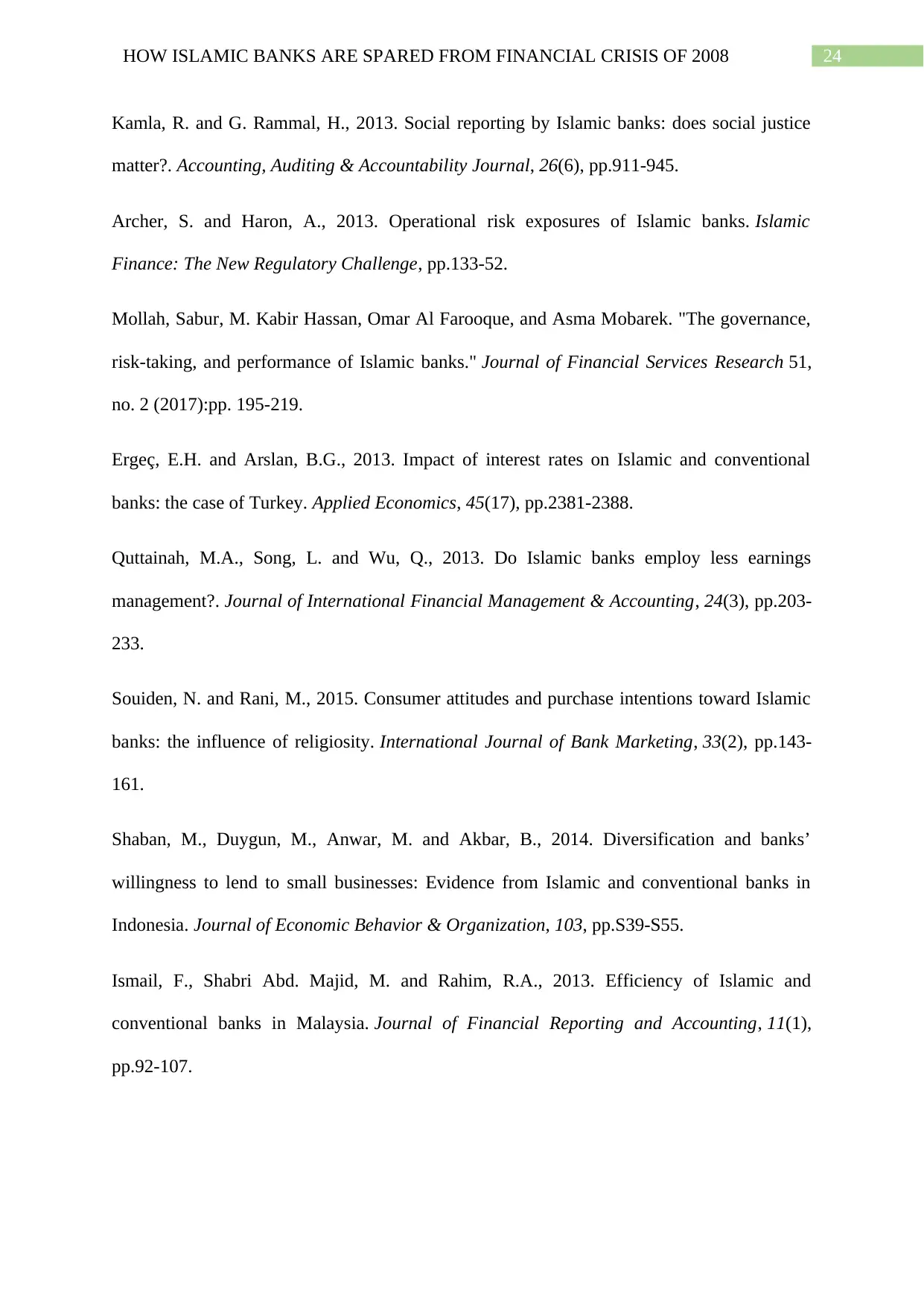
24HOW ISLAMIC BANKS ARE SPARED FROM FINANCIAL CRISIS OF 2008
Kamla, R. and G. Rammal, H., 2013. Social reporting by Islamic banks: does social justice
matter?. Accounting, Auditing & Accountability Journal, 26(6), pp.911-945.
Archer, S. and Haron, A., 2013. Operational risk exposures of Islamic banks. Islamic
Finance: The New Regulatory Challenge, pp.133-52.
Mollah, Sabur, M. Kabir Hassan, Omar Al Farooque, and Asma Mobarek. "The governance,
risk-taking, and performance of Islamic banks." Journal of Financial Services Research 51,
no. 2 (2017):pp. 195-219.
Ergeç, E.H. and Arslan, B.G., 2013. Impact of interest rates on Islamic and conventional
banks: the case of Turkey. Applied Economics, 45(17), pp.2381-2388.
Quttainah, M.A., Song, L. and Wu, Q., 2013. Do Islamic banks employ less earnings
management?. Journal of International Financial Management & Accounting, 24(3), pp.203-
233.
Souiden, N. and Rani, M., 2015. Consumer attitudes and purchase intentions toward Islamic
banks: the influence of religiosity. International Journal of Bank Marketing, 33(2), pp.143-
161.
Shaban, M., Duygun, M., Anwar, M. and Akbar, B., 2014. Diversification and banks’
willingness to lend to small businesses: Evidence from Islamic and conventional banks in
Indonesia. Journal of Economic Behavior & Organization, 103, pp.S39-S55.
Ismail, F., Shabri Abd. Majid, M. and Rahim, R.A., 2013. Efficiency of Islamic and
conventional banks in Malaysia. Journal of Financial Reporting and Accounting, 11(1),
pp.92-107.
Kamla, R. and G. Rammal, H., 2013. Social reporting by Islamic banks: does social justice
matter?. Accounting, Auditing & Accountability Journal, 26(6), pp.911-945.
Archer, S. and Haron, A., 2013. Operational risk exposures of Islamic banks. Islamic
Finance: The New Regulatory Challenge, pp.133-52.
Mollah, Sabur, M. Kabir Hassan, Omar Al Farooque, and Asma Mobarek. "The governance,
risk-taking, and performance of Islamic banks." Journal of Financial Services Research 51,
no. 2 (2017):pp. 195-219.
Ergeç, E.H. and Arslan, B.G., 2013. Impact of interest rates on Islamic and conventional
banks: the case of Turkey. Applied Economics, 45(17), pp.2381-2388.
Quttainah, M.A., Song, L. and Wu, Q., 2013. Do Islamic banks employ less earnings
management?. Journal of International Financial Management & Accounting, 24(3), pp.203-
233.
Souiden, N. and Rani, M., 2015. Consumer attitudes and purchase intentions toward Islamic
banks: the influence of religiosity. International Journal of Bank Marketing, 33(2), pp.143-
161.
Shaban, M., Duygun, M., Anwar, M. and Akbar, B., 2014. Diversification and banks’
willingness to lend to small businesses: Evidence from Islamic and conventional banks in
Indonesia. Journal of Economic Behavior & Organization, 103, pp.S39-S55.
Ismail, F., Shabri Abd. Majid, M. and Rahim, R.A., 2013. Efficiency of Islamic and
conventional banks in Malaysia. Journal of Financial Reporting and Accounting, 11(1),
pp.92-107.
Paraphrase This Document
Need a fresh take? Get an instant paraphrase of this document with our AI Paraphraser
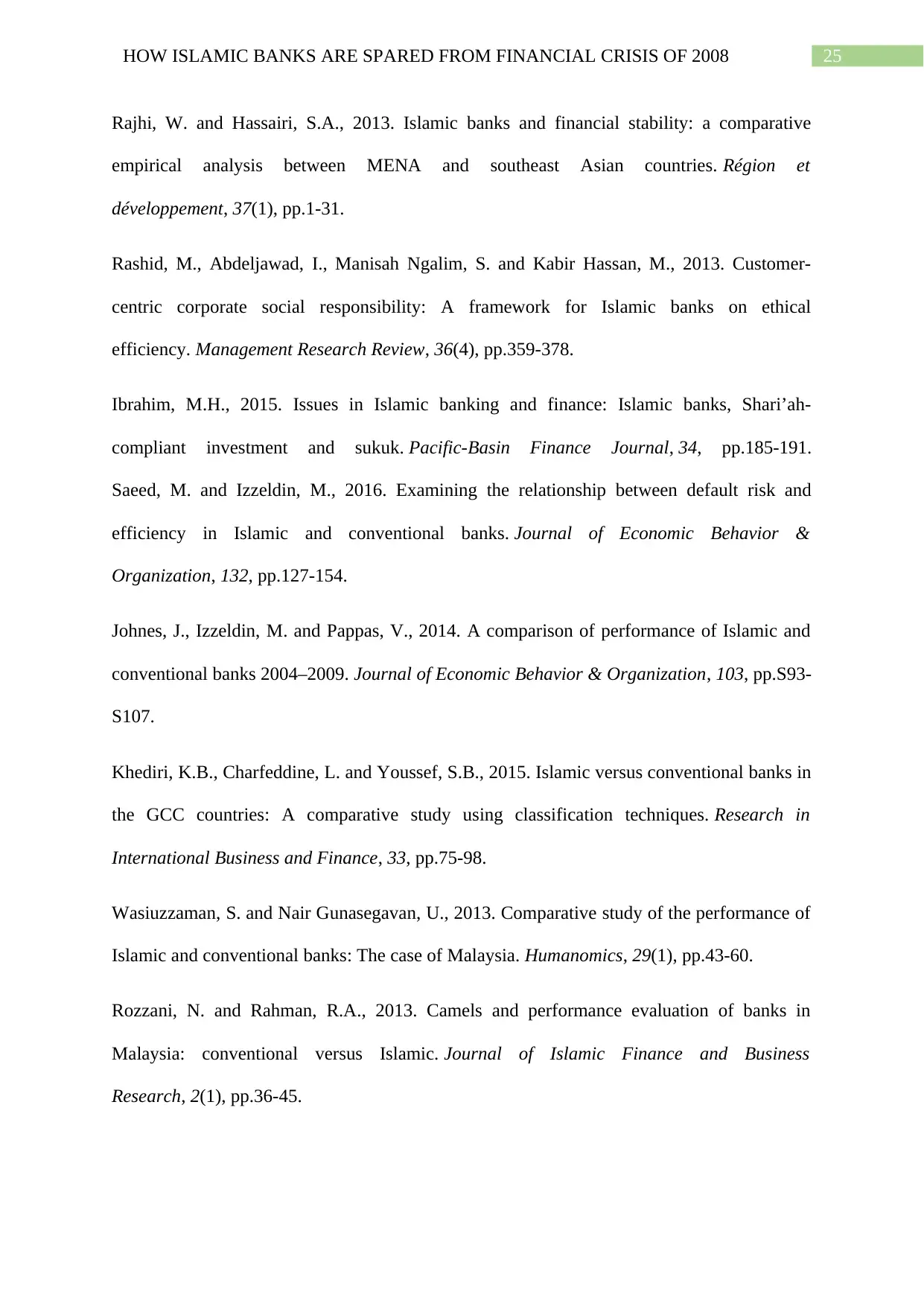
25HOW ISLAMIC BANKS ARE SPARED FROM FINANCIAL CRISIS OF 2008
Rajhi, W. and Hassairi, S.A., 2013. Islamic banks and financial stability: a comparative
empirical analysis between MENA and southeast Asian countries. Région et
développement, 37(1), pp.1-31.
Rashid, M., Abdeljawad, I., Manisah Ngalim, S. and Kabir Hassan, M., 2013. Customer-
centric corporate social responsibility: A framework for Islamic banks on ethical
efficiency. Management Research Review, 36(4), pp.359-378.
Ibrahim, M.H., 2015. Issues in Islamic banking and finance: Islamic banks, Shari’ah-
compliant investment and sukuk. Pacific-Basin Finance Journal, 34, pp.185-191.
Saeed, M. and Izzeldin, M., 2016. Examining the relationship between default risk and
efficiency in Islamic and conventional banks. Journal of Economic Behavior &
Organization, 132, pp.127-154.
Johnes, J., Izzeldin, M. and Pappas, V., 2014. A comparison of performance of Islamic and
conventional banks 2004–2009. Journal of Economic Behavior & Organization, 103, pp.S93-
S107.
Khediri, K.B., Charfeddine, L. and Youssef, S.B., 2015. Islamic versus conventional banks in
the GCC countries: A comparative study using classification techniques. Research in
International Business and Finance, 33, pp.75-98.
Wasiuzzaman, S. and Nair Gunasegavan, U., 2013. Comparative study of the performance of
Islamic and conventional banks: The case of Malaysia. Humanomics, 29(1), pp.43-60.
Rozzani, N. and Rahman, R.A., 2013. Camels and performance evaluation of banks in
Malaysia: conventional versus Islamic. Journal of Islamic Finance and Business
Research, 2(1), pp.36-45.
Rajhi, W. and Hassairi, S.A., 2013. Islamic banks and financial stability: a comparative
empirical analysis between MENA and southeast Asian countries. Région et
développement, 37(1), pp.1-31.
Rashid, M., Abdeljawad, I., Manisah Ngalim, S. and Kabir Hassan, M., 2013. Customer-
centric corporate social responsibility: A framework for Islamic banks on ethical
efficiency. Management Research Review, 36(4), pp.359-378.
Ibrahim, M.H., 2015. Issues in Islamic banking and finance: Islamic banks, Shari’ah-
compliant investment and sukuk. Pacific-Basin Finance Journal, 34, pp.185-191.
Saeed, M. and Izzeldin, M., 2016. Examining the relationship between default risk and
efficiency in Islamic and conventional banks. Journal of Economic Behavior &
Organization, 132, pp.127-154.
Johnes, J., Izzeldin, M. and Pappas, V., 2014. A comparison of performance of Islamic and
conventional banks 2004–2009. Journal of Economic Behavior & Organization, 103, pp.S93-
S107.
Khediri, K.B., Charfeddine, L. and Youssef, S.B., 2015. Islamic versus conventional banks in
the GCC countries: A comparative study using classification techniques. Research in
International Business and Finance, 33, pp.75-98.
Wasiuzzaman, S. and Nair Gunasegavan, U., 2013. Comparative study of the performance of
Islamic and conventional banks: The case of Malaysia. Humanomics, 29(1), pp.43-60.
Rozzani, N. and Rahman, R.A., 2013. Camels and performance evaluation of banks in
Malaysia: conventional versus Islamic. Journal of Islamic Finance and Business
Research, 2(1), pp.36-45.
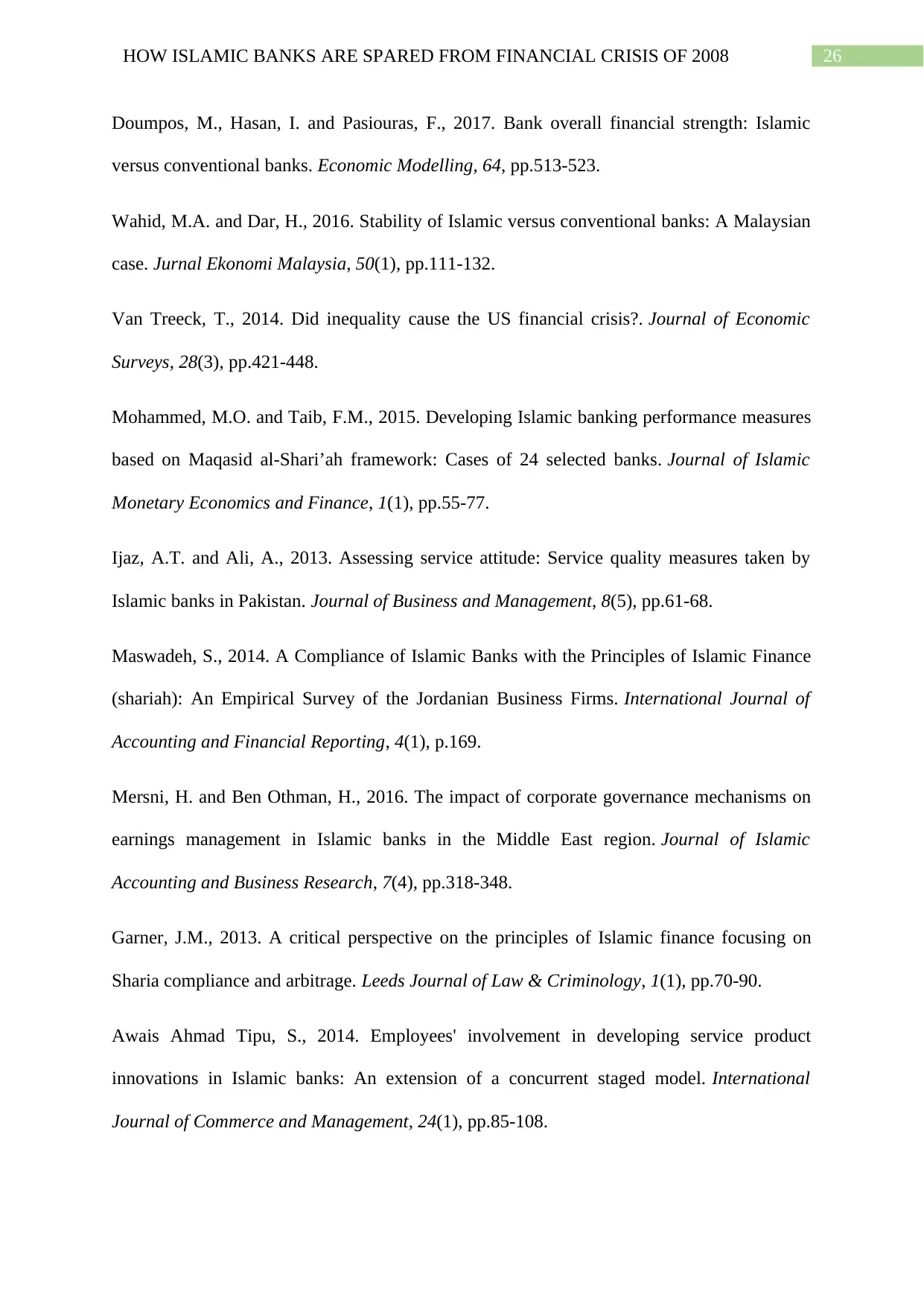
26HOW ISLAMIC BANKS ARE SPARED FROM FINANCIAL CRISIS OF 2008
Doumpos, M., Hasan, I. and Pasiouras, F., 2017. Bank overall financial strength: Islamic
versus conventional banks. Economic Modelling, 64, pp.513-523.
Wahid, M.A. and Dar, H., 2016. Stability of Islamic versus conventional banks: A Malaysian
case. Jurnal Ekonomi Malaysia, 50(1), pp.111-132.
Van Treeck, T., 2014. Did inequality cause the US financial crisis?. Journal of Economic
Surveys, 28(3), pp.421-448.
Mohammed, M.O. and Taib, F.M., 2015. Developing Islamic banking performance measures
based on Maqasid al-Shari’ah framework: Cases of 24 selected banks. Journal of Islamic
Monetary Economics and Finance, 1(1), pp.55-77.
Ijaz, A.T. and Ali, A., 2013. Assessing service attitude: Service quality measures taken by
Islamic banks in Pakistan. Journal of Business and Management, 8(5), pp.61-68.
Maswadeh, S., 2014. A Compliance of Islamic Banks with the Principles of Islamic Finance
(shariah): An Empirical Survey of the Jordanian Business Firms. International Journal of
Accounting and Financial Reporting, 4(1), p.169.
Mersni, H. and Ben Othman, H., 2016. The impact of corporate governance mechanisms on
earnings management in Islamic banks in the Middle East region. Journal of Islamic
Accounting and Business Research, 7(4), pp.318-348.
Garner, J.M., 2013. A critical perspective on the principles of Islamic finance focusing on
Sharia compliance and arbitrage. Leeds Journal of Law & Criminology, 1(1), pp.70-90.
Awais Ahmad Tipu, S., 2014. Employees' involvement in developing service product
innovations in Islamic banks: An extension of a concurrent staged model. International
Journal of Commerce and Management, 24(1), pp.85-108.
Doumpos, M., Hasan, I. and Pasiouras, F., 2017. Bank overall financial strength: Islamic
versus conventional banks. Economic Modelling, 64, pp.513-523.
Wahid, M.A. and Dar, H., 2016. Stability of Islamic versus conventional banks: A Malaysian
case. Jurnal Ekonomi Malaysia, 50(1), pp.111-132.
Van Treeck, T., 2014. Did inequality cause the US financial crisis?. Journal of Economic
Surveys, 28(3), pp.421-448.
Mohammed, M.O. and Taib, F.M., 2015. Developing Islamic banking performance measures
based on Maqasid al-Shari’ah framework: Cases of 24 selected banks. Journal of Islamic
Monetary Economics and Finance, 1(1), pp.55-77.
Ijaz, A.T. and Ali, A., 2013. Assessing service attitude: Service quality measures taken by
Islamic banks in Pakistan. Journal of Business and Management, 8(5), pp.61-68.
Maswadeh, S., 2014. A Compliance of Islamic Banks with the Principles of Islamic Finance
(shariah): An Empirical Survey of the Jordanian Business Firms. International Journal of
Accounting and Financial Reporting, 4(1), p.169.
Mersni, H. and Ben Othman, H., 2016. The impact of corporate governance mechanisms on
earnings management in Islamic banks in the Middle East region. Journal of Islamic
Accounting and Business Research, 7(4), pp.318-348.
Garner, J.M., 2013. A critical perspective on the principles of Islamic finance focusing on
Sharia compliance and arbitrage. Leeds Journal of Law & Criminology, 1(1), pp.70-90.
Awais Ahmad Tipu, S., 2014. Employees' involvement in developing service product
innovations in Islamic banks: An extension of a concurrent staged model. International
Journal of Commerce and Management, 24(1), pp.85-108.
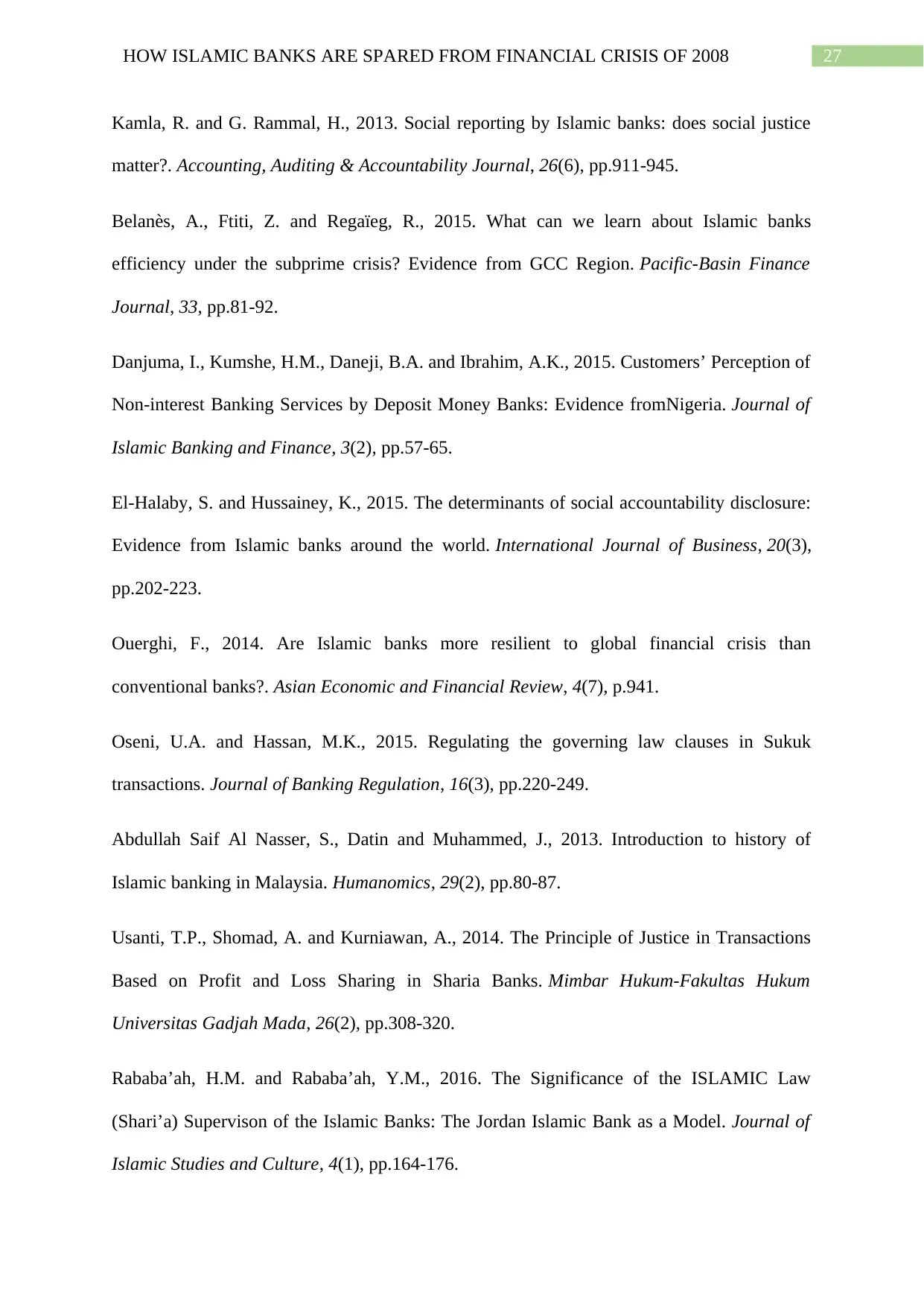
27HOW ISLAMIC BANKS ARE SPARED FROM FINANCIAL CRISIS OF 2008
Kamla, R. and G. Rammal, H., 2013. Social reporting by Islamic banks: does social justice
matter?. Accounting, Auditing & Accountability Journal, 26(6), pp.911-945.
Belanès, A., Ftiti, Z. and Regaïeg, R., 2015. What can we learn about Islamic banks
efficiency under the subprime crisis? Evidence from GCC Region. Pacific-Basin Finance
Journal, 33, pp.81-92.
Danjuma, I., Kumshe, H.M., Daneji, B.A. and Ibrahim, A.K., 2015. Customers’ Perception of
Non-interest Banking Services by Deposit Money Banks: Evidence fromNigeria. Journal of
Islamic Banking and Finance, 3(2), pp.57-65.
El-Halaby, S. and Hussainey, K., 2015. The determinants of social accountability disclosure:
Evidence from Islamic banks around the world. International Journal of Business, 20(3),
pp.202-223.
Ouerghi, F., 2014. Are Islamic banks more resilient to global financial crisis than
conventional banks?. Asian Economic and Financial Review, 4(7), p.941.
Oseni, U.A. and Hassan, M.K., 2015. Regulating the governing law clauses in Sukuk
transactions. Journal of Banking Regulation, 16(3), pp.220-249.
Abdullah Saif Al Nasser, S., Datin and Muhammed, J., 2013. Introduction to history of
Islamic banking in Malaysia. Humanomics, 29(2), pp.80-87.
Usanti, T.P., Shomad, A. and Kurniawan, A., 2014. The Principle of Justice in Transactions
Based on Profit and Loss Sharing in Sharia Banks. Mimbar Hukum-Fakultas Hukum
Universitas Gadjah Mada, 26(2), pp.308-320.
Rababa’ah, H.M. and Rababa’ah, Y.M., 2016. The Significance of the ISLAMIC Law
(Shari’a) Supervison of the Islamic Banks: The Jordan Islamic Bank as a Model. Journal of
Islamic Studies and Culture, 4(1), pp.164-176.
Kamla, R. and G. Rammal, H., 2013. Social reporting by Islamic banks: does social justice
matter?. Accounting, Auditing & Accountability Journal, 26(6), pp.911-945.
Belanès, A., Ftiti, Z. and Regaïeg, R., 2015. What can we learn about Islamic banks
efficiency under the subprime crisis? Evidence from GCC Region. Pacific-Basin Finance
Journal, 33, pp.81-92.
Danjuma, I., Kumshe, H.M., Daneji, B.A. and Ibrahim, A.K., 2015. Customers’ Perception of
Non-interest Banking Services by Deposit Money Banks: Evidence fromNigeria. Journal of
Islamic Banking and Finance, 3(2), pp.57-65.
El-Halaby, S. and Hussainey, K., 2015. The determinants of social accountability disclosure:
Evidence from Islamic banks around the world. International Journal of Business, 20(3),
pp.202-223.
Ouerghi, F., 2014. Are Islamic banks more resilient to global financial crisis than
conventional banks?. Asian Economic and Financial Review, 4(7), p.941.
Oseni, U.A. and Hassan, M.K., 2015. Regulating the governing law clauses in Sukuk
transactions. Journal of Banking Regulation, 16(3), pp.220-249.
Abdullah Saif Al Nasser, S., Datin and Muhammed, J., 2013. Introduction to history of
Islamic banking in Malaysia. Humanomics, 29(2), pp.80-87.
Usanti, T.P., Shomad, A. and Kurniawan, A., 2014. The Principle of Justice in Transactions
Based on Profit and Loss Sharing in Sharia Banks. Mimbar Hukum-Fakultas Hukum
Universitas Gadjah Mada, 26(2), pp.308-320.
Rababa’ah, H.M. and Rababa’ah, Y.M., 2016. The Significance of the ISLAMIC Law
(Shari’a) Supervison of the Islamic Banks: The Jordan Islamic Bank as a Model. Journal of
Islamic Studies and Culture, 4(1), pp.164-176.
Secure Best Marks with AI Grader
Need help grading? Try our AI Grader for instant feedback on your assignments.
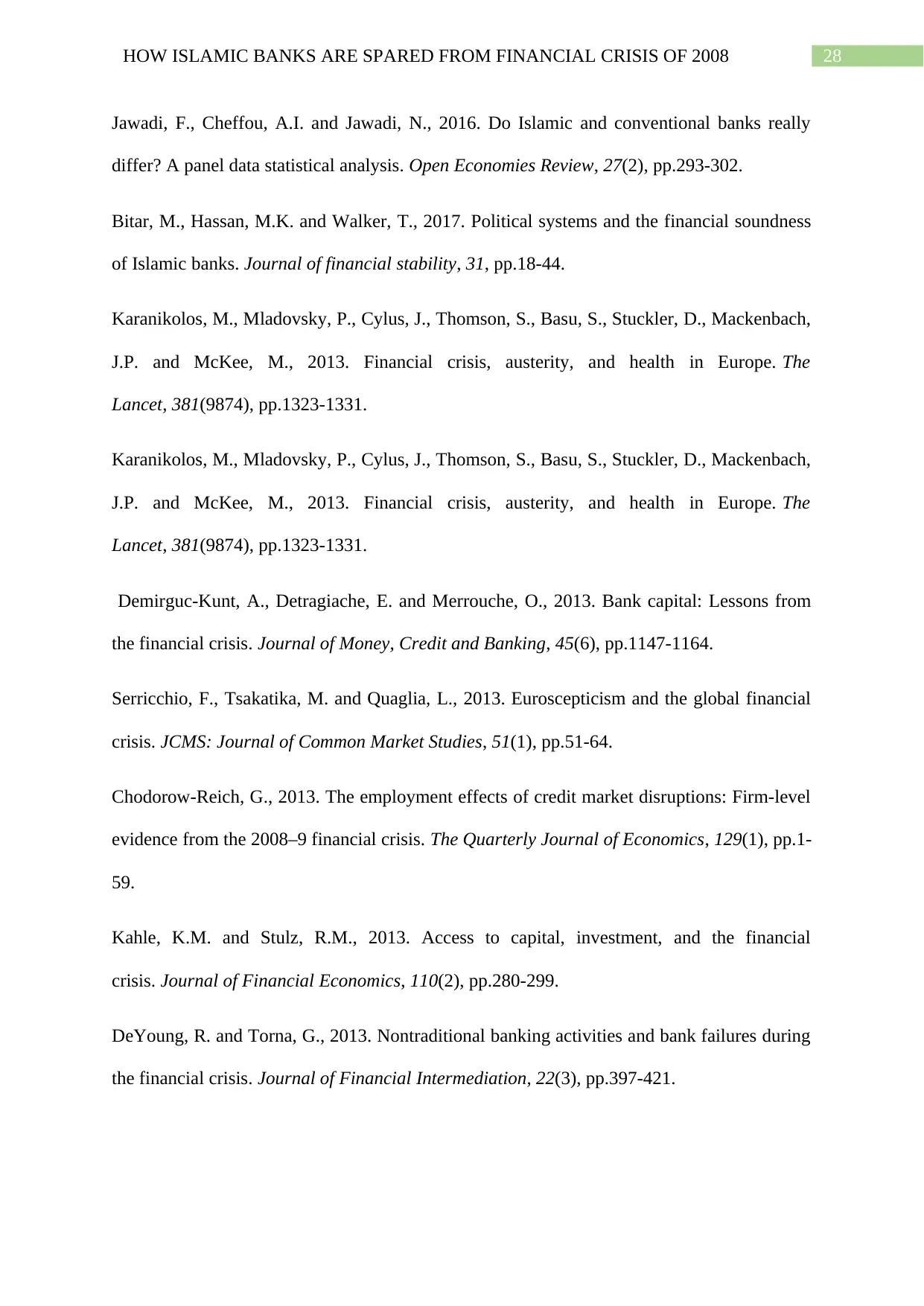
28HOW ISLAMIC BANKS ARE SPARED FROM FINANCIAL CRISIS OF 2008
Jawadi, F., Cheffou, A.I. and Jawadi, N., 2016. Do Islamic and conventional banks really
differ? A panel data statistical analysis. Open Economies Review, 27(2), pp.293-302.
Bitar, M., Hassan, M.K. and Walker, T., 2017. Political systems and the financial soundness
of Islamic banks. Journal of financial stability, 31, pp.18-44.
Karanikolos, M., Mladovsky, P., Cylus, J., Thomson, S., Basu, S., Stuckler, D., Mackenbach,
J.P. and McKee, M., 2013. Financial crisis, austerity, and health in Europe. The
Lancet, 381(9874), pp.1323-1331.
Karanikolos, M., Mladovsky, P., Cylus, J., Thomson, S., Basu, S., Stuckler, D., Mackenbach,
J.P. and McKee, M., 2013. Financial crisis, austerity, and health in Europe. The
Lancet, 381(9874), pp.1323-1331.
Demirguc‐Kunt, A., Detragiache, E. and Merrouche, O., 2013. Bank capital: Lessons from
the financial crisis. Journal of Money, Credit and Banking, 45(6), pp.1147-1164.
Serricchio, F., Tsakatika, M. and Quaglia, L., 2013. Euroscepticism and the global financial
crisis. JCMS: Journal of Common Market Studies, 51(1), pp.51-64.
Chodorow-Reich, G., 2013. The employment effects of credit market disruptions: Firm-level
evidence from the 2008–9 financial crisis. The Quarterly Journal of Economics, 129(1), pp.1-
59.
Kahle, K.M. and Stulz, R.M., 2013. Access to capital, investment, and the financial
crisis. Journal of Financial Economics, 110(2), pp.280-299.
DeYoung, R. and Torna, G., 2013. Nontraditional banking activities and bank failures during
the financial crisis. Journal of Financial Intermediation, 22(3), pp.397-421.
Jawadi, F., Cheffou, A.I. and Jawadi, N., 2016. Do Islamic and conventional banks really
differ? A panel data statistical analysis. Open Economies Review, 27(2), pp.293-302.
Bitar, M., Hassan, M.K. and Walker, T., 2017. Political systems and the financial soundness
of Islamic banks. Journal of financial stability, 31, pp.18-44.
Karanikolos, M., Mladovsky, P., Cylus, J., Thomson, S., Basu, S., Stuckler, D., Mackenbach,
J.P. and McKee, M., 2013. Financial crisis, austerity, and health in Europe. The
Lancet, 381(9874), pp.1323-1331.
Karanikolos, M., Mladovsky, P., Cylus, J., Thomson, S., Basu, S., Stuckler, D., Mackenbach,
J.P. and McKee, M., 2013. Financial crisis, austerity, and health in Europe. The
Lancet, 381(9874), pp.1323-1331.
Demirguc‐Kunt, A., Detragiache, E. and Merrouche, O., 2013. Bank capital: Lessons from
the financial crisis. Journal of Money, Credit and Banking, 45(6), pp.1147-1164.
Serricchio, F., Tsakatika, M. and Quaglia, L., 2013. Euroscepticism and the global financial
crisis. JCMS: Journal of Common Market Studies, 51(1), pp.51-64.
Chodorow-Reich, G., 2013. The employment effects of credit market disruptions: Firm-level
evidence from the 2008–9 financial crisis. The Quarterly Journal of Economics, 129(1), pp.1-
59.
Kahle, K.M. and Stulz, R.M., 2013. Access to capital, investment, and the financial
crisis. Journal of Financial Economics, 110(2), pp.280-299.
DeYoung, R. and Torna, G., 2013. Nontraditional banking activities and bank failures during
the financial crisis. Journal of Financial Intermediation, 22(3), pp.397-421.
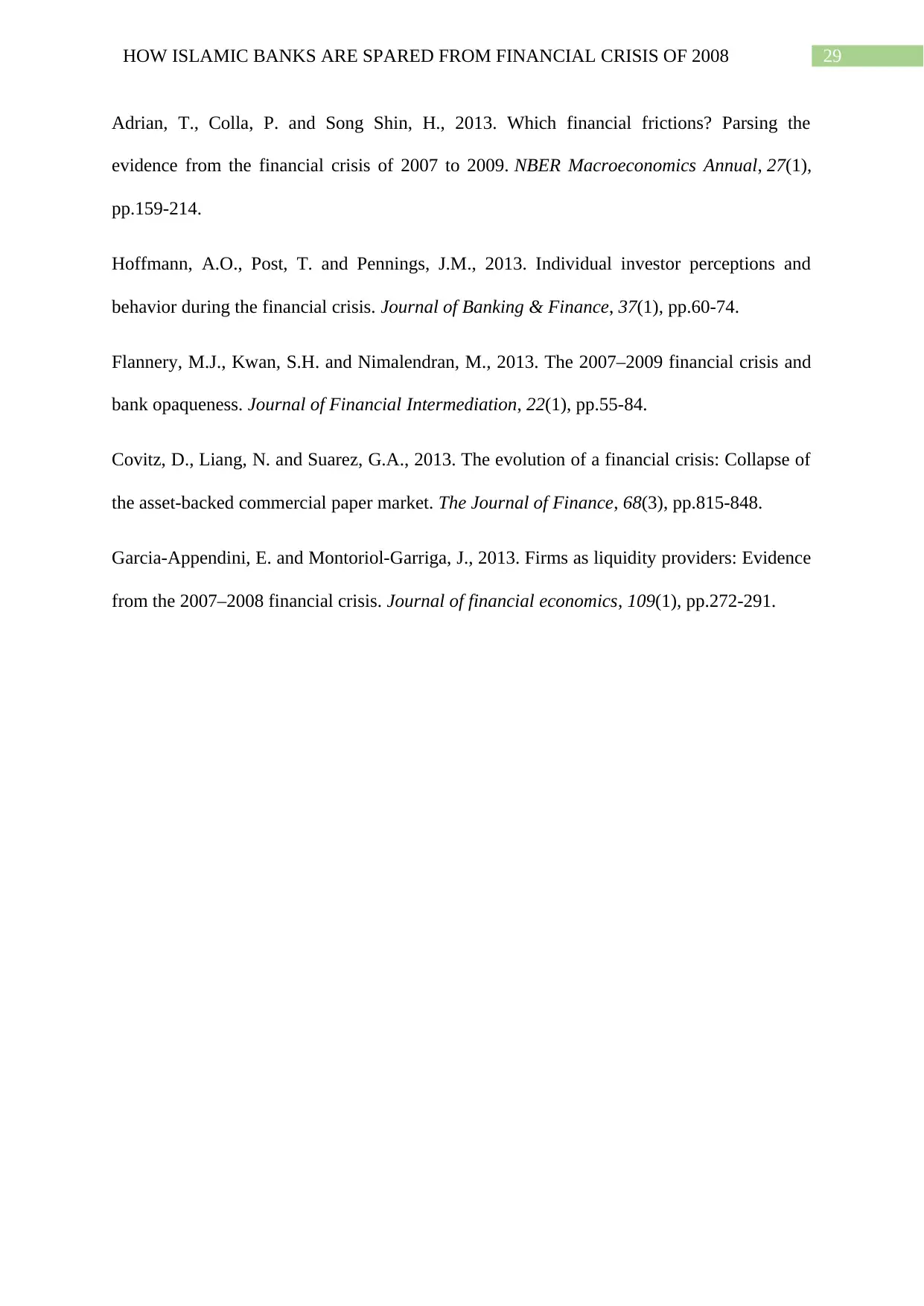
29HOW ISLAMIC BANKS ARE SPARED FROM FINANCIAL CRISIS OF 2008
Adrian, T., Colla, P. and Song Shin, H., 2013. Which financial frictions? Parsing the
evidence from the financial crisis of 2007 to 2009. NBER Macroeconomics Annual, 27(1),
pp.159-214.
Hoffmann, A.O., Post, T. and Pennings, J.M., 2013. Individual investor perceptions and
behavior during the financial crisis. Journal of Banking & Finance, 37(1), pp.60-74.
Flannery, M.J., Kwan, S.H. and Nimalendran, M., 2013. The 2007–2009 financial crisis and
bank opaqueness. Journal of Financial Intermediation, 22(1), pp.55-84.
Covitz, D., Liang, N. and Suarez, G.A., 2013. The evolution of a financial crisis: Collapse of
the asset‐backed commercial paper market. The Journal of Finance, 68(3), pp.815-848.
Garcia-Appendini, E. and Montoriol-Garriga, J., 2013. Firms as liquidity providers: Evidence
from the 2007–2008 financial crisis. Journal of financial economics, 109(1), pp.272-291.
Adrian, T., Colla, P. and Song Shin, H., 2013. Which financial frictions? Parsing the
evidence from the financial crisis of 2007 to 2009. NBER Macroeconomics Annual, 27(1),
pp.159-214.
Hoffmann, A.O., Post, T. and Pennings, J.M., 2013. Individual investor perceptions and
behavior during the financial crisis. Journal of Banking & Finance, 37(1), pp.60-74.
Flannery, M.J., Kwan, S.H. and Nimalendran, M., 2013. The 2007–2009 financial crisis and
bank opaqueness. Journal of Financial Intermediation, 22(1), pp.55-84.
Covitz, D., Liang, N. and Suarez, G.A., 2013. The evolution of a financial crisis: Collapse of
the asset‐backed commercial paper market. The Journal of Finance, 68(3), pp.815-848.
Garcia-Appendini, E. and Montoriol-Garriga, J., 2013. Firms as liquidity providers: Evidence
from the 2007–2008 financial crisis. Journal of financial economics, 109(1), pp.272-291.
1 out of 30
Related Documents
Your All-in-One AI-Powered Toolkit for Academic Success.
+13062052269
info@desklib.com
Available 24*7 on WhatsApp / Email
![[object Object]](/_next/static/media/star-bottom.7253800d.svg)
Unlock your academic potential
© 2024 | Zucol Services PVT LTD | All rights reserved.





